
From October 18th to December 11th, the Tokyo National Museum (hereinafter referred to as Tohaku) is holding a special exhibition "National Treasures: All About the Tokyo National Museum" .
In this exhibition commemorating the 150th anniversary of the founding of the museum, all 89 national treasures owned by the Tokyo Expo, as well as many important cultural properties will be on display! Even if you're not an art fan, you can't miss the content.
Since I participated in the press preview that was held prior to the event, I will report in detail on the state of the venue, which is too luxurious.
*Advance reservations are required for this exhibition (specified date and time).
*Exhibitions will be changed during the exhibition period.
*All works are owned by the Tokyo National Museum unless otherwise specified.
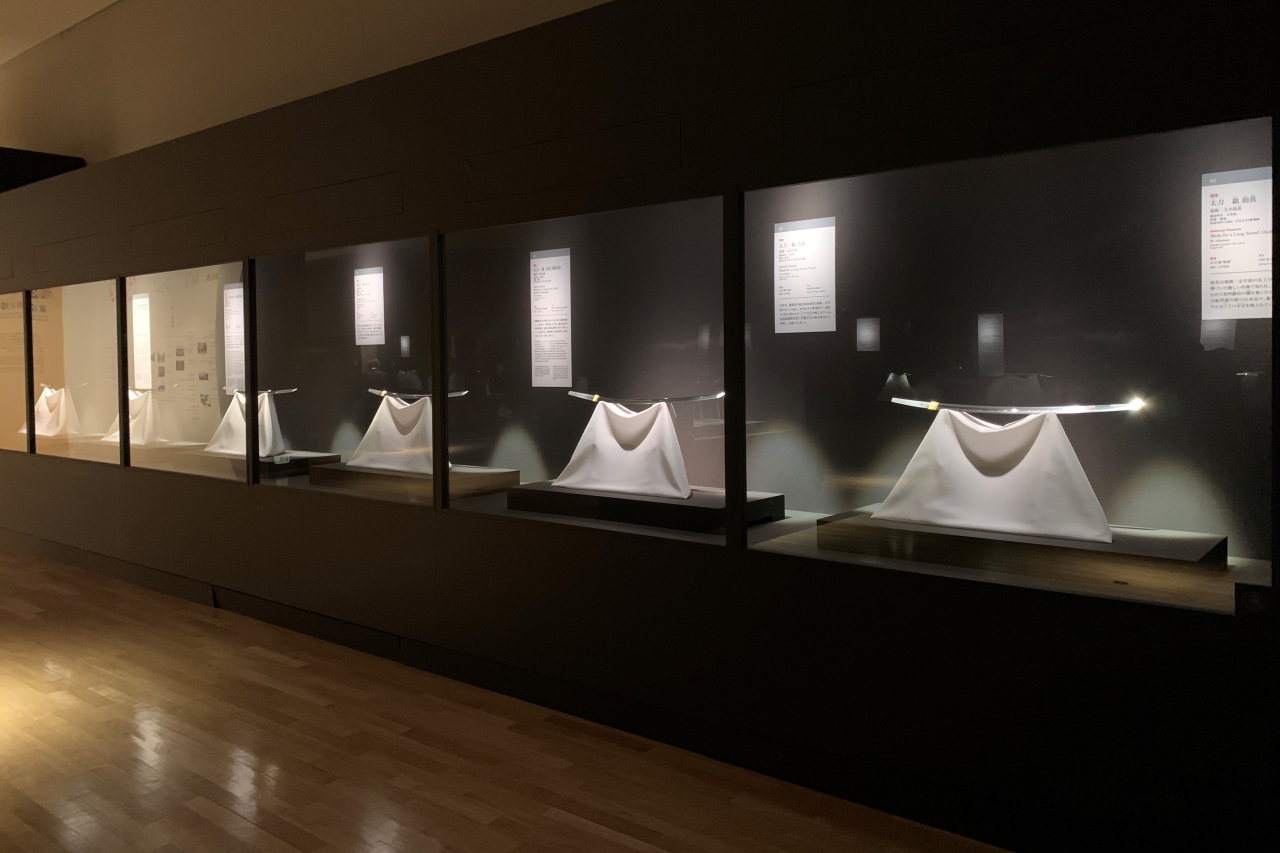
Installation view "National Treasure Sword Room"
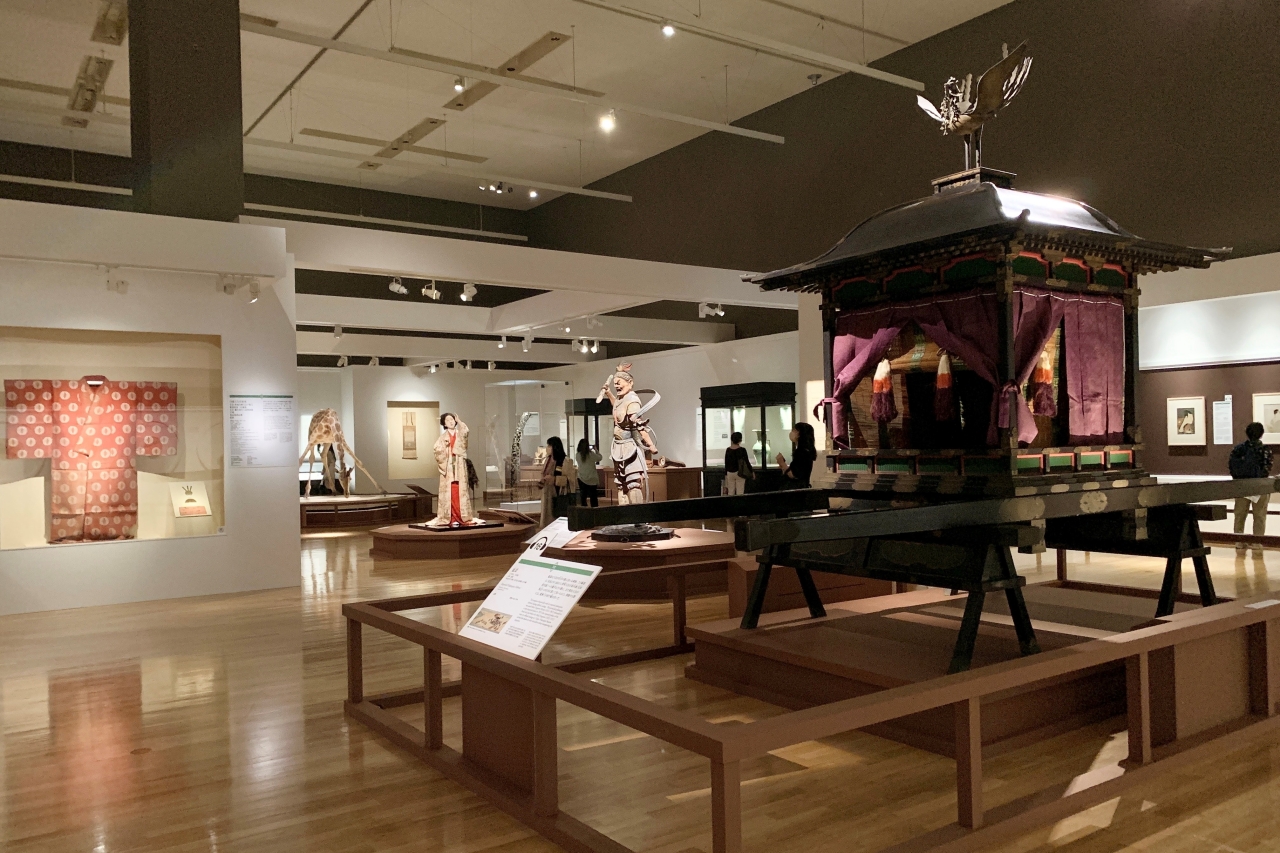
Exhibition view
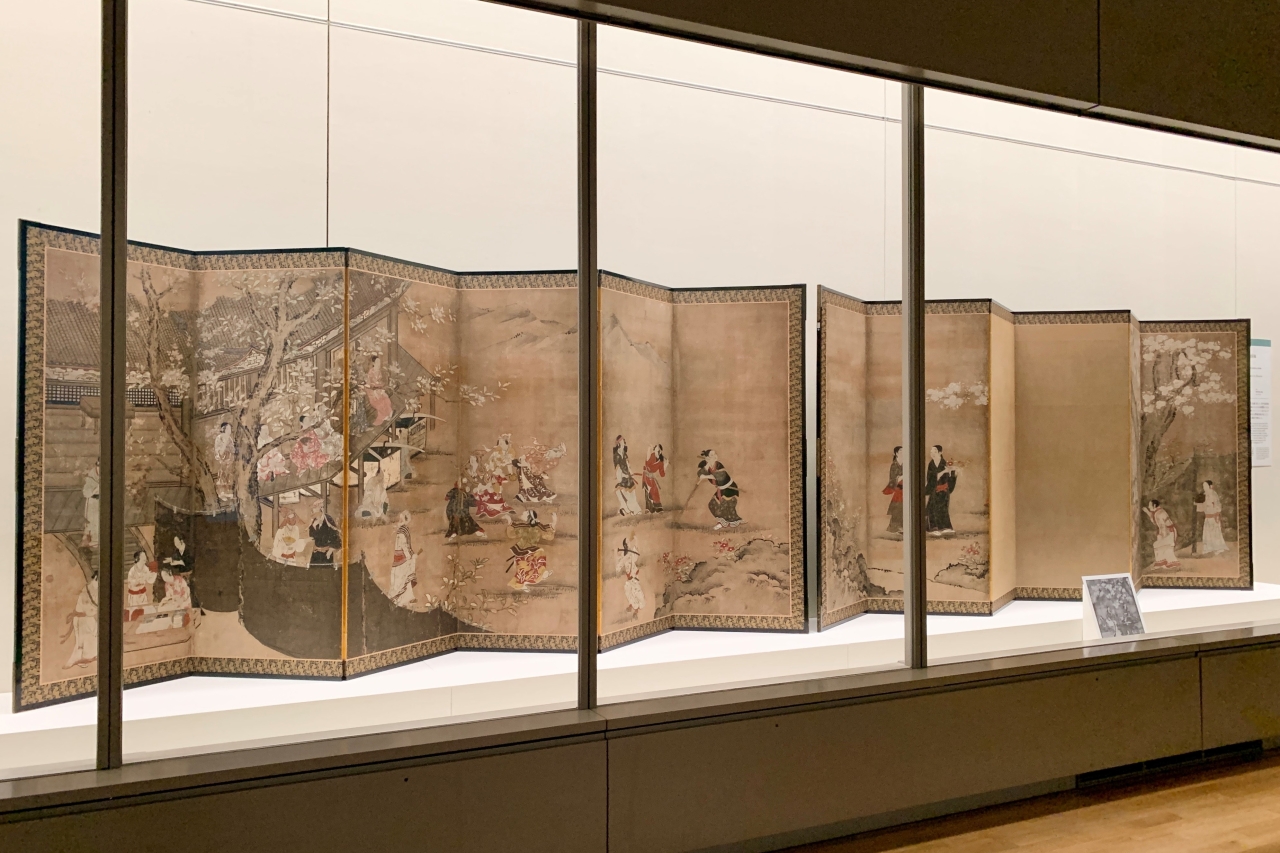
Installation view, Naganobu Kano 《Pleasure under Flowers》 Edo period, 17th century Exhibition period: 10/18-11/13
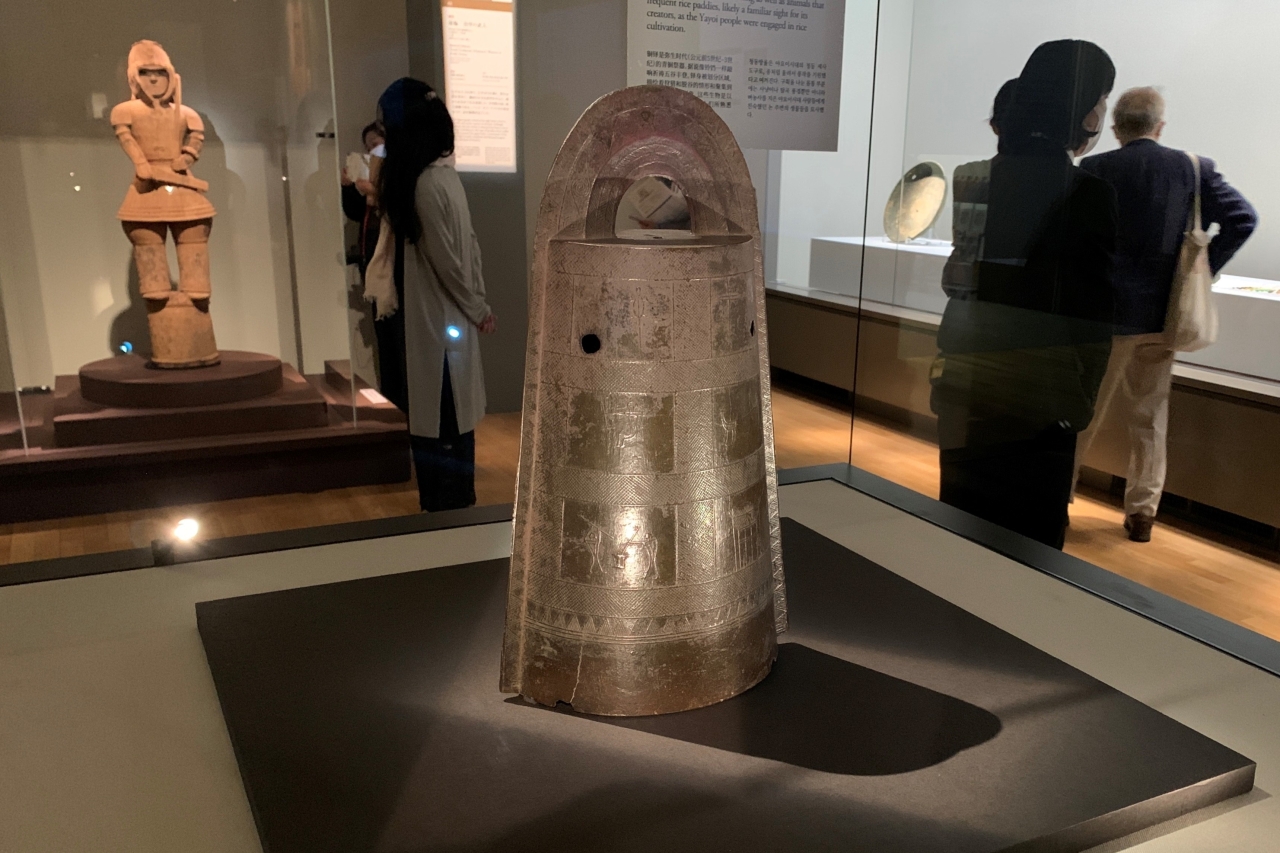
Installation view, photo in the foreground: "Flat Knob Dotaku" Originating from Kagawa Prefecture, Yayoi period, 2nd to 1st century BC, Exhibition period: 10/18 – 12/11
It will be difficult to realize in the next 50 years! ? Opening of a marvelous exhibition
The special exhibition "National Treasures: All of the Tokyo National Museum" aims to introduce the entire picture of Tohaku, the museum with the longest history of 150 years in Japan. This is an exhibition that displays masterpieces, including , and related materials that tell the history of 150 years since the Meiji era.
Tohaku's collection of national treasures is the largest in Japan, with 89 works representing about 10% of the arts and crafts currently designated as national treasures. Just by looking at the number, you should be able to understand how special this exhibition is.
Of course, such an exhibition is unprecedented, the first in history!
At a press conference held in May of this year, even the researchers of the Tokyo Expo said that they had never seen a scene in which all 89 national treasures were displayed.
It seems that it was very difficult to adjust the detailed exhibition plan from several years ago, and he said, "The next exhibition may be held at the 200th anniversary, 50 years later ." It may be a once-in-a-lifetime chance, so if you are interested, I would like you to adjust your schedule.
Tohaku Hasegawa, Sesshu, Koetsu Honami…The essence of beauty can now be found at the Tokyo Expo
This exhibition consists of two parts, " Part 1: National Treasures of the Tokyo National Museum" and "Part 2: 150 Years of the Tokyo National Museum ."
"Part 1 National Treasures of the Tokyo National Museum" is an area where only national treasures are simply displayed as far as the eye can see. The breakdown of the 89 national treasures is 21 paintings, 14 calligraphy, 4 oriental paintings, 10 oriental calligraphy, 11 Horyuji treasures, 6 archeology, 4 lacquer works, and 19 swords .
*Please note that all national treasures cannot be viewed in one visit, as they are all open to the public, including exhibition changes. (It seems that around 60 national treasures can be viewed in one visit at any time.)
In addition, all exhibition schedules are published on the exhibition official website .
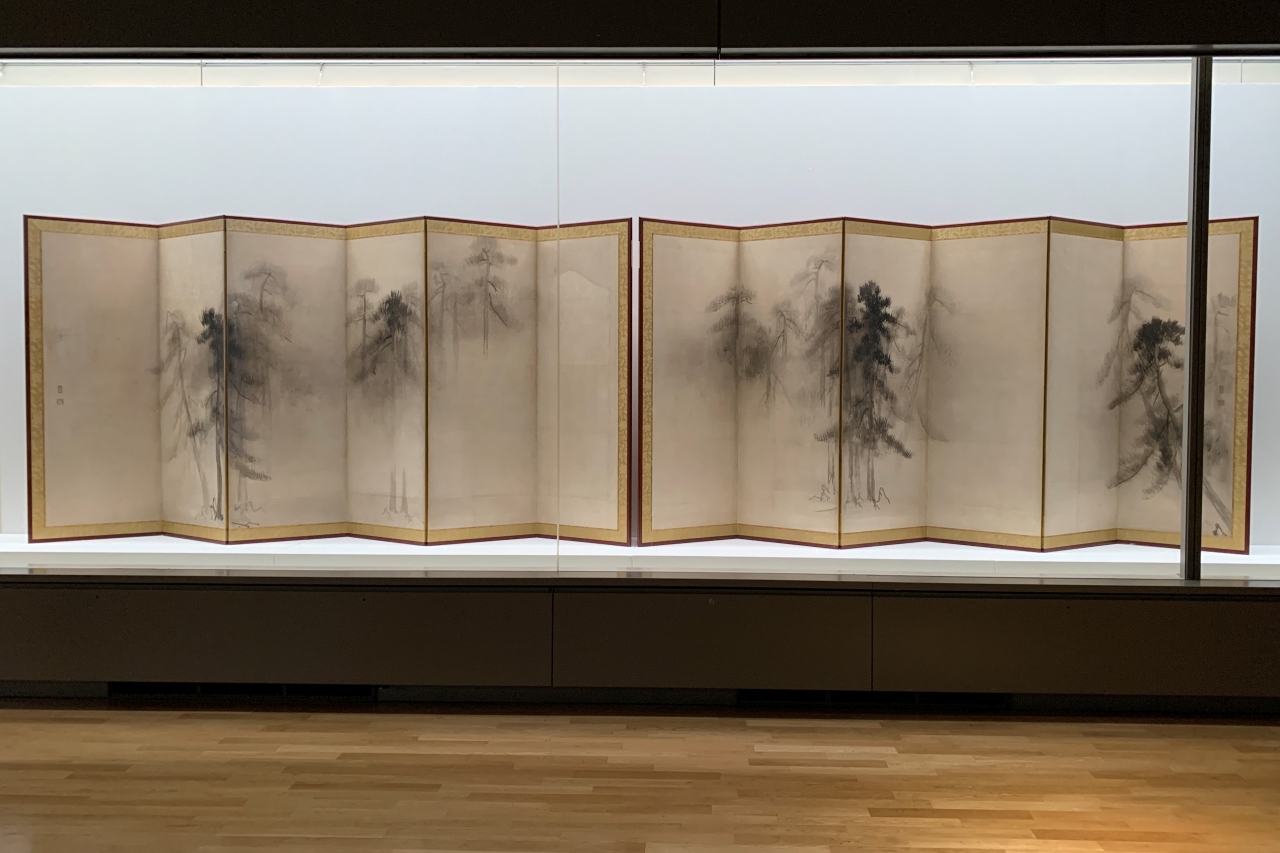
Hasegawa Tohaku, Pine forest folding screen, Azuchi-Momoyama period, 16th century Exhibition period: 10/18-30
When you enter the venue, instead of a greeting, you will be greeted by Tohaku Hasegawa, a painter who was active in the Azuchi-Momoyama period.
It is one of the National Treasures that makes you think, "This is what Tohaku is all about." Its elegant appearance takes your breath away every time you see it. You can even feel the humidity of the cool air surrounding the pine forest. The pine tree has a mysterious and mysterious atmosphere, but if you look closer, you will be overwhelmed by the surprisingly intense brushwork.
It is said to be the pinnacle of Japanese ink painting, but the interesting point is that there is suspicion that it was actually a sketch.
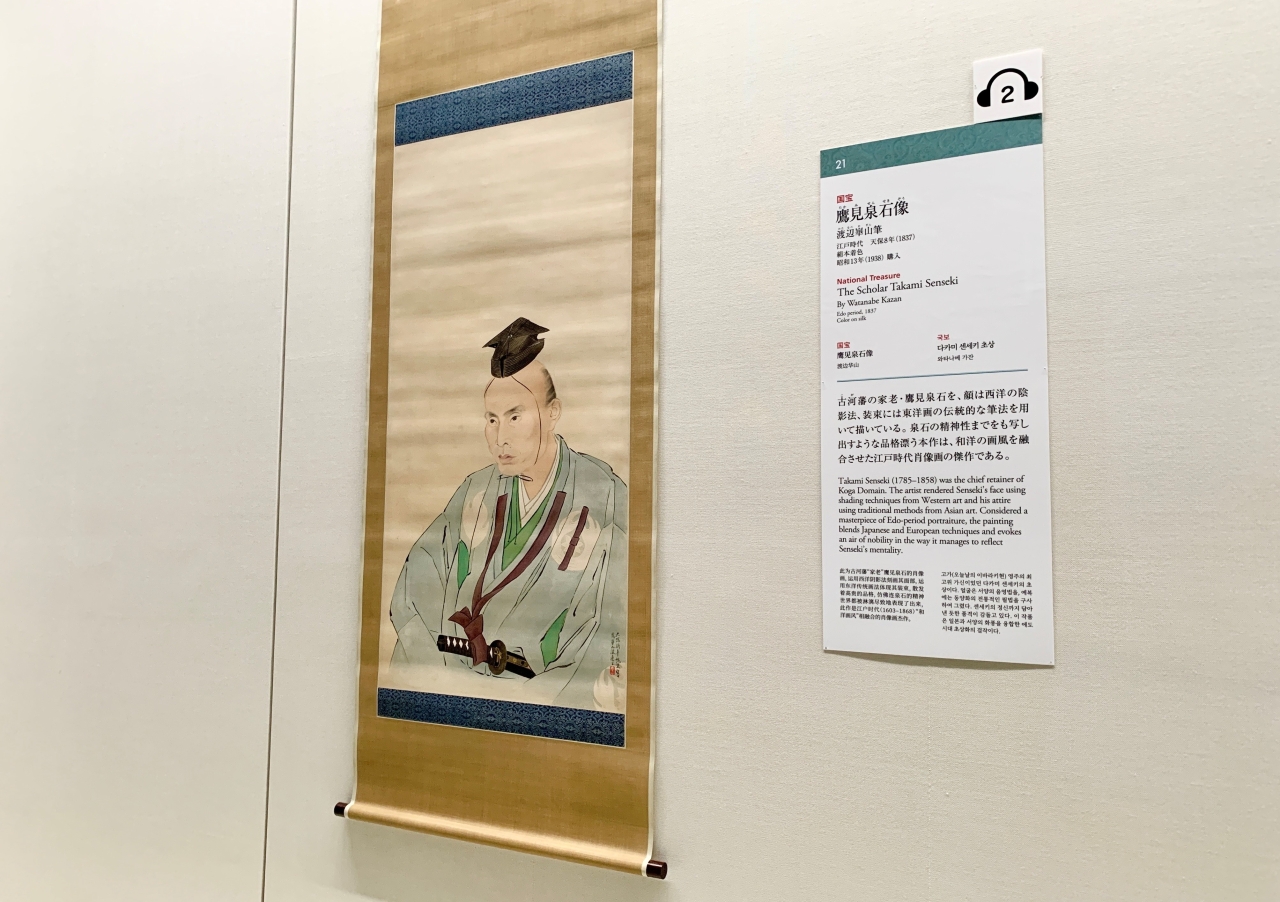
Installation view, by Kazan Watanabe 《Stone statue of Izumi Takami》Edo period 1837 Exhibition period: 10/18-11/13
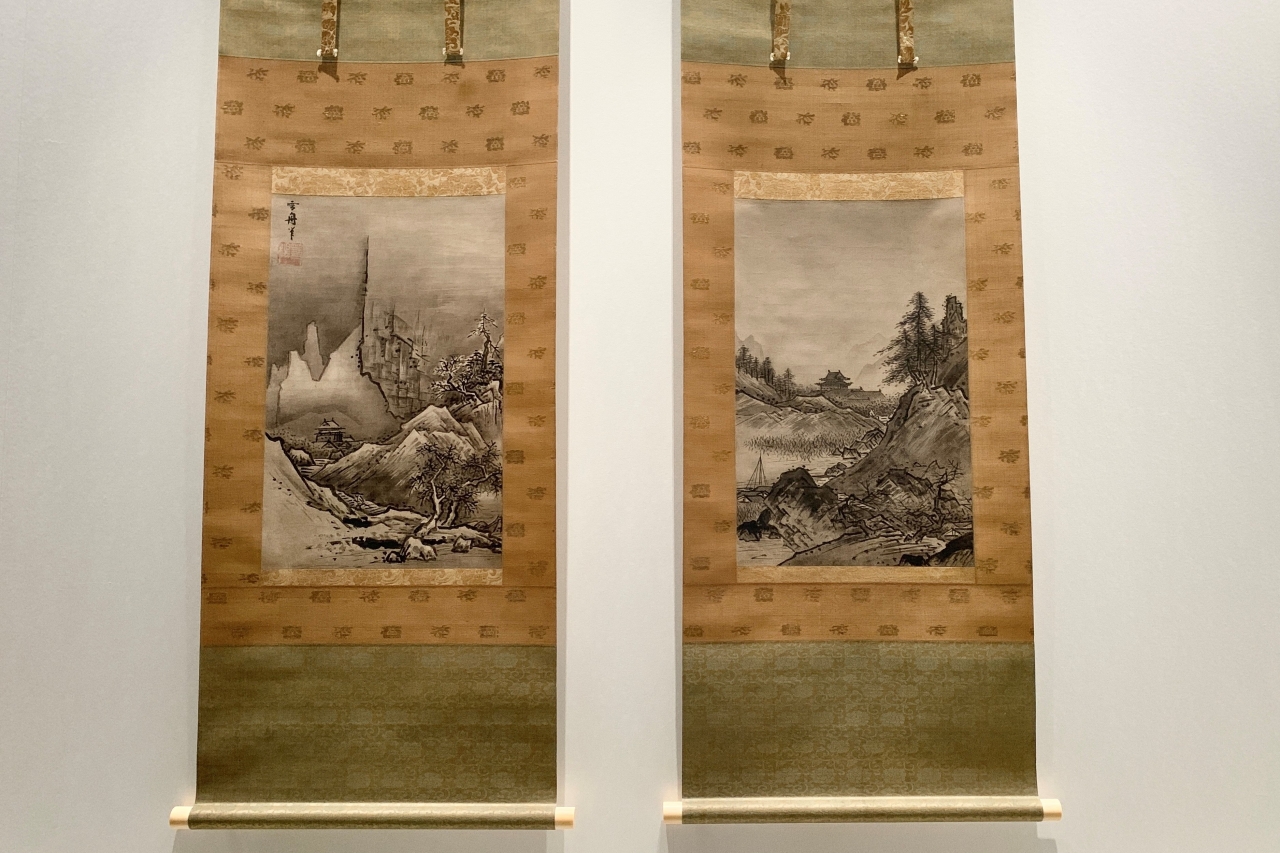
By Sesshu Toyo, Autumn and Winter Landscape, Muromachi period, 15th-16th century, Exhibition period: 10/18-11/13

《Kujaku Myoo Statue》 Heian period, 12th century, Exhibition period: 10/18-11/13
The statue of Kujaku Myo-o, a Buddhist painting representative of the Heian period, has a beautiful symmetrical composition, and the gorgeous colors such as red, gold, green, and indigo are eye-catching.
The skin is faint and reddish, and the outline is pink, giving it a plump and soft impression. Myoo has an angry face by default, but Kujaku Myoo is an exception, and this Peacock Myoo also has a gentle and loving expression like a bodhisattva. When I face each other, my heart becomes more and more calm.
If you look even closer, you can see the wonderful kirikane patterns that use gold leaf and gold paint on clothes, accessories, and peacock feathers! It's hard to notice because it's faded over time, but the craftsmanship of the lower body is a must-see. How bright was it at the time?
Peacock Myo-o is said to ward off people's misfortunes, but since the auspicious fruit he holds is a pomegranate, which is also considered a symbol of the prosperity of his descendants, it is believed that the painting was commissioned by high-ranking aristocrats to pray for safe childbirth. that there is

《Heiji Monogatari Illustrated Scroll Rokuhara Gyoko》Kamakura period, 13th century, donated by Mr. Naoaki Matsudaira, exhibition period: 10/18-30
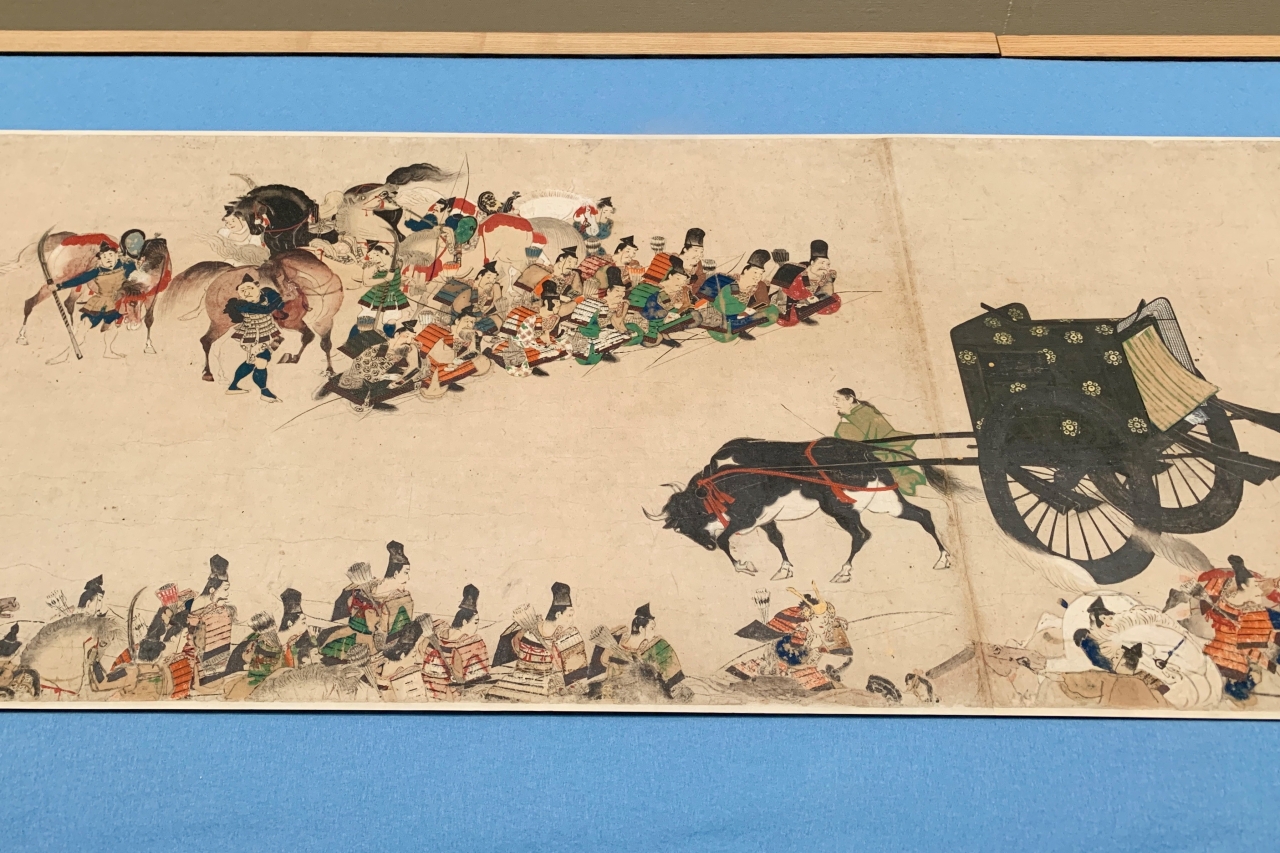
《Heiji Monogatari Emaki, Rokuhara Gyoko Scroll》 (detail)
Also worth noting is the Kamakura era battle picture scroll masterpiece Heiji Monogatari Emaki Rokuhara Gyoko Scroll .
Based on the Heiji Rebellion, it depicts the situation before and after the imprisoned Emperor Nijo tried to escape while dressed as a court lady and escaped to Kiyomori Taira's Rokuhara residence. It is a work that you can enjoy the realistic depiction of the samurai's armor and swords, but because the total length is about 9m50cm, it seems that it is not common for exhibitions to display all of them due to space limitations.
However, it is indeed a national treasure exhibition! It was exhibited so that all scenes could be appreciated without omission. However, it will be open to the public until October 30th. Please note that the exhibition is for 2 weeks only.
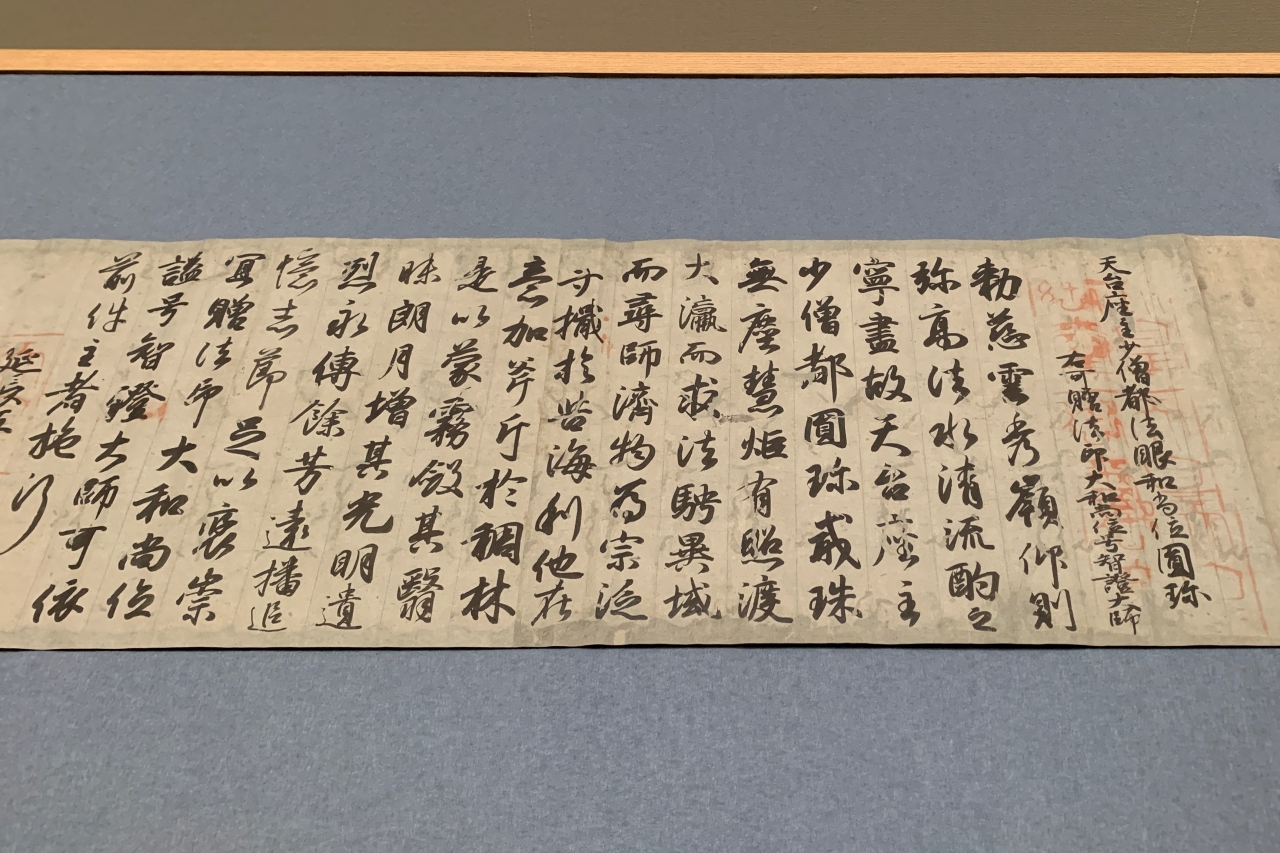
By Ono no Michifu, Enchin-Giving Hoin Dai-Osho-I-Nami-Sho-Daishi-Shi-Go-Isho (detail), Heian period, 5 years extension (927) Exhibition period: 10/18 – 11/13
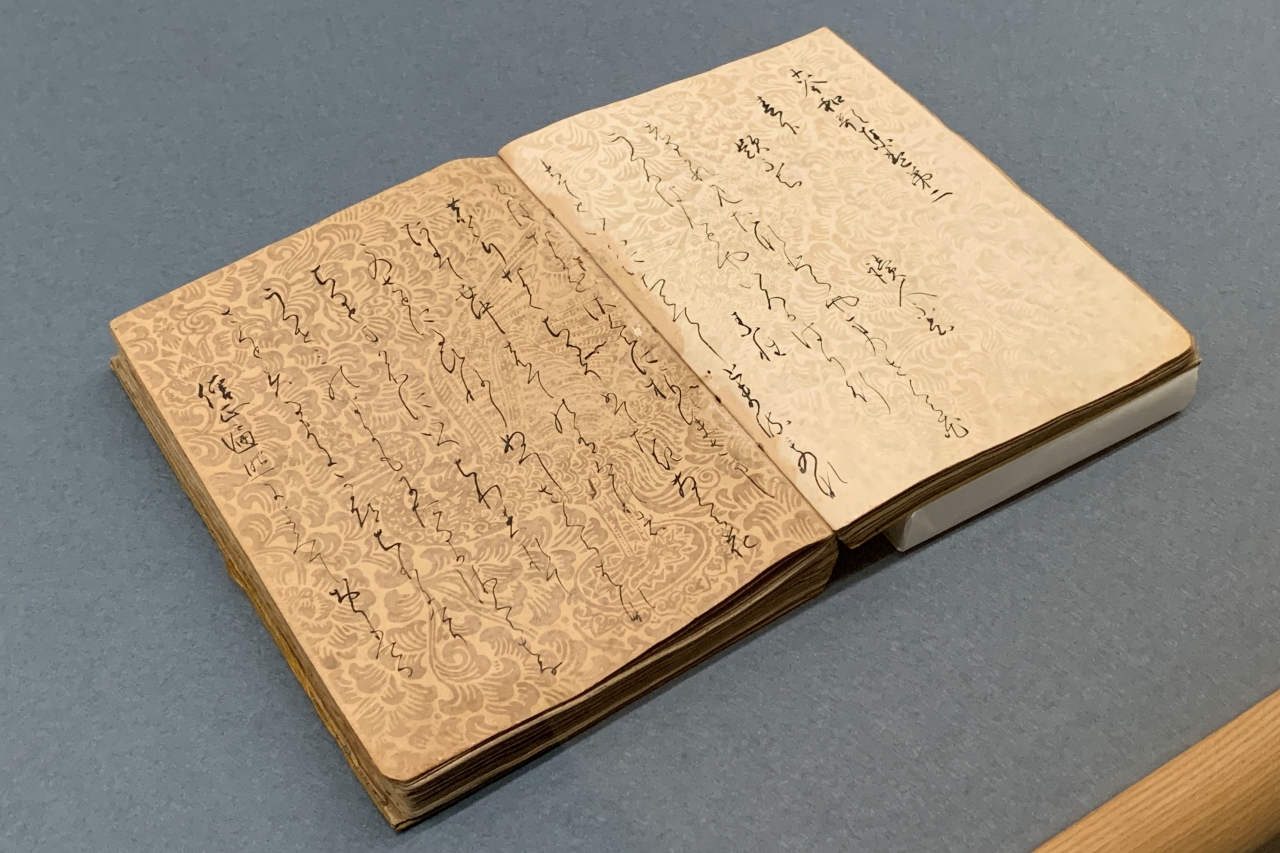
《Kokin Wakashu (Motonaga version)》 Kamijo, Heian period, 12th century, Exhibition period: 10/18-12/11, page change during the exhibition
Among the calligraphy, it is said to have been written by Emperor Shomu , and its magnificent large characters with plenty of ink are attractive. , 8th century, exhibition period: October 18th to November 13th), and Murasaki Shikibu, one of the Sanseki, wrote in "The Tale of Genji", The calligraphy looks so dazzling. ” You can appreciate works such as the Enchin-Giho-in Dai-Osho-I-Nami-Sho-Daishi Post-God Chronicle by calligrapher Ono Michifu.
Kokin Wakashu (Kokin Wakashu) is the oldest surviving relic of the Kokin Wakashu in its original binding. Luxurious writing paper that feels the sense of beauty is also a highlight.
The writing is composed mostly of kana, and the light brush strokes that match the writing paper seemed to convey the rhythm of the waka poems when read aloud.
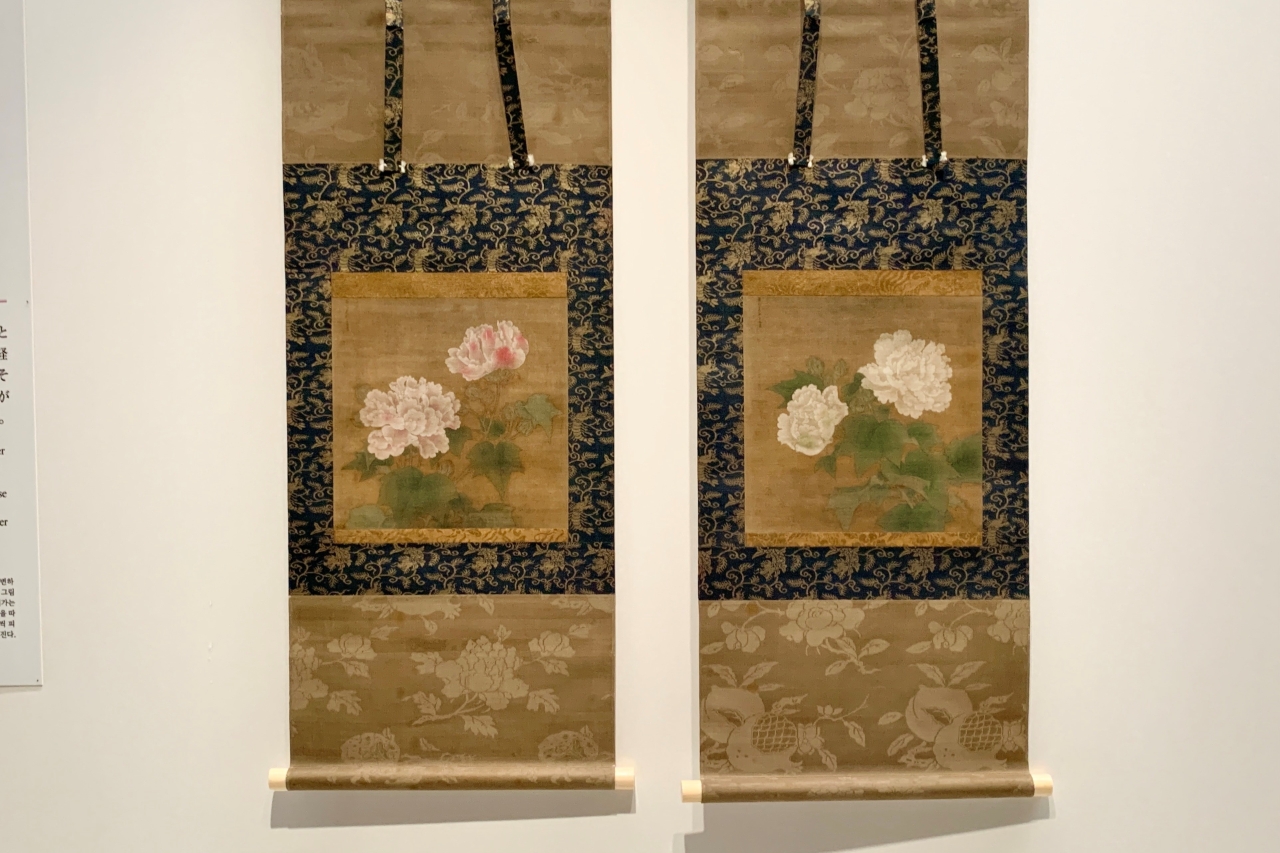
Red and White Lotus Leaf by Li Di, Southern Song Dynasty, China, 1197, Exhibition period: 10/18 – 11/13
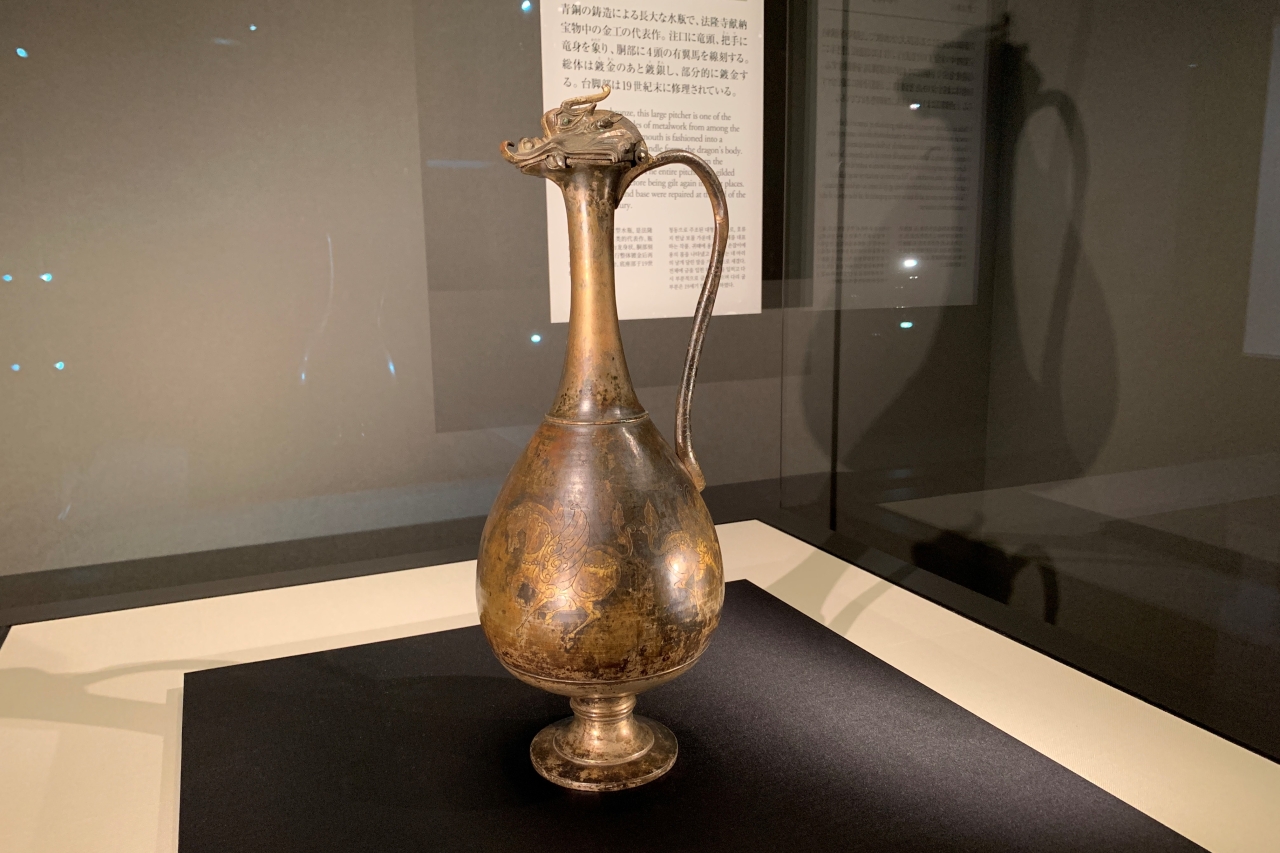
《Dragon Neck Water Bottle》Asuka period, 7th century, Exhibition period: 10/18-12/11

Honami Koetsu, Funabashi Maki-e Inkstone Box, Edo period, 17th century, Exhibition period: 10/18-11/13
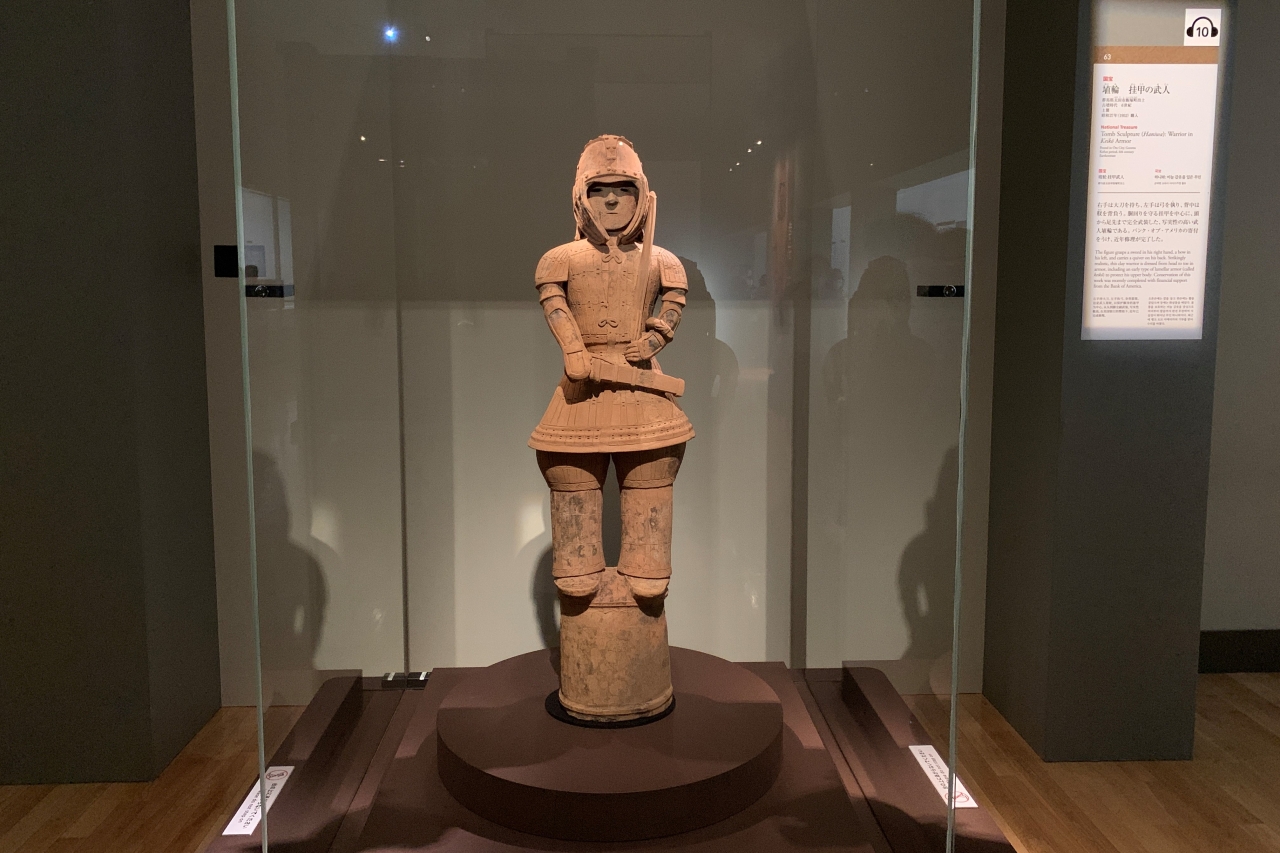
《Terracotta Warrior in Armor》 Kofun period, 6th century, Exhibition period: 10/18-12/11
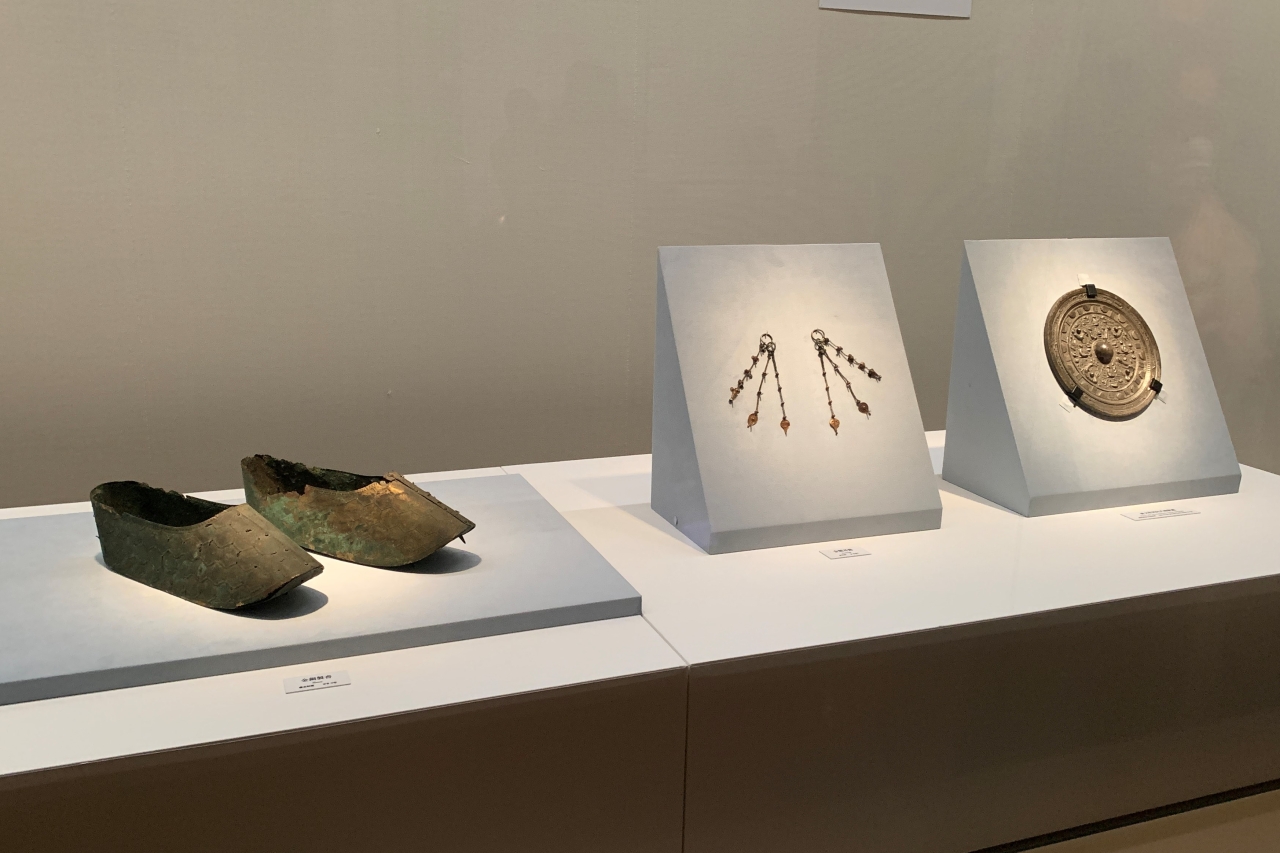
《Artifacts excavated from the Eta Funayama Burial Mound》 3 points. Gilt-bronze shoes on the left, Joseon Three Kingdoms period, 5th-6th centuries, exhibition period: 10/18-12/11
For convenience, I have introduced some of the many paintings and calligraphy works, but to be honest, there are only highlights!
Some of the works, such as the Eta Funayama Tumulus excavated items , gave me the opportunity to learn that there were national treasures like this, but basically the old ones are from B.C. to the Edo period in the 19th century. The work will appear soon. It is frightening that the captions of the works are lined with unusual adjectives such as "the oldest in existence" and "the highest peak".
The aura of the National Treasures will burn your brain, so we recommend that you make sure you are in good physical condition and have enough time to stay and take breaks.

Scenery of the venue
By the way, as you can see in the picture, the exhibition space is quite wide and there are many chairs, so it seems that you can go around at your own pace.
As the exhibition progresses, Kano Eitoku's Cypress Screen Folding Screen (Exhibition period: 11/1-11/27), Iwasa Matabei's Rakuchu Rakugai-Zu Folding Screen (Funaki Version) (Exhibition period: 11/15-12) /11), Korin Ogata's "Yatsuhashi Maki-e Mother-of-Pearl Inkstone Box" (Exhibition period: November 15-December 11) will appear.
You can also enjoy “Mikazuki” by Mikazuki Munechika! "National Treasure Sword Room"

"National Treasure Sword Room"

《Nashiji mother-of-pearl gold decorated sword》Heian period, 12th century, exhibition period: all year
Before the opening, it became a hot topic on SNS, etc., but in the second half of the first part, the "National Treasure Sword Room" appeared, where only 19 national treasure swords were collected .
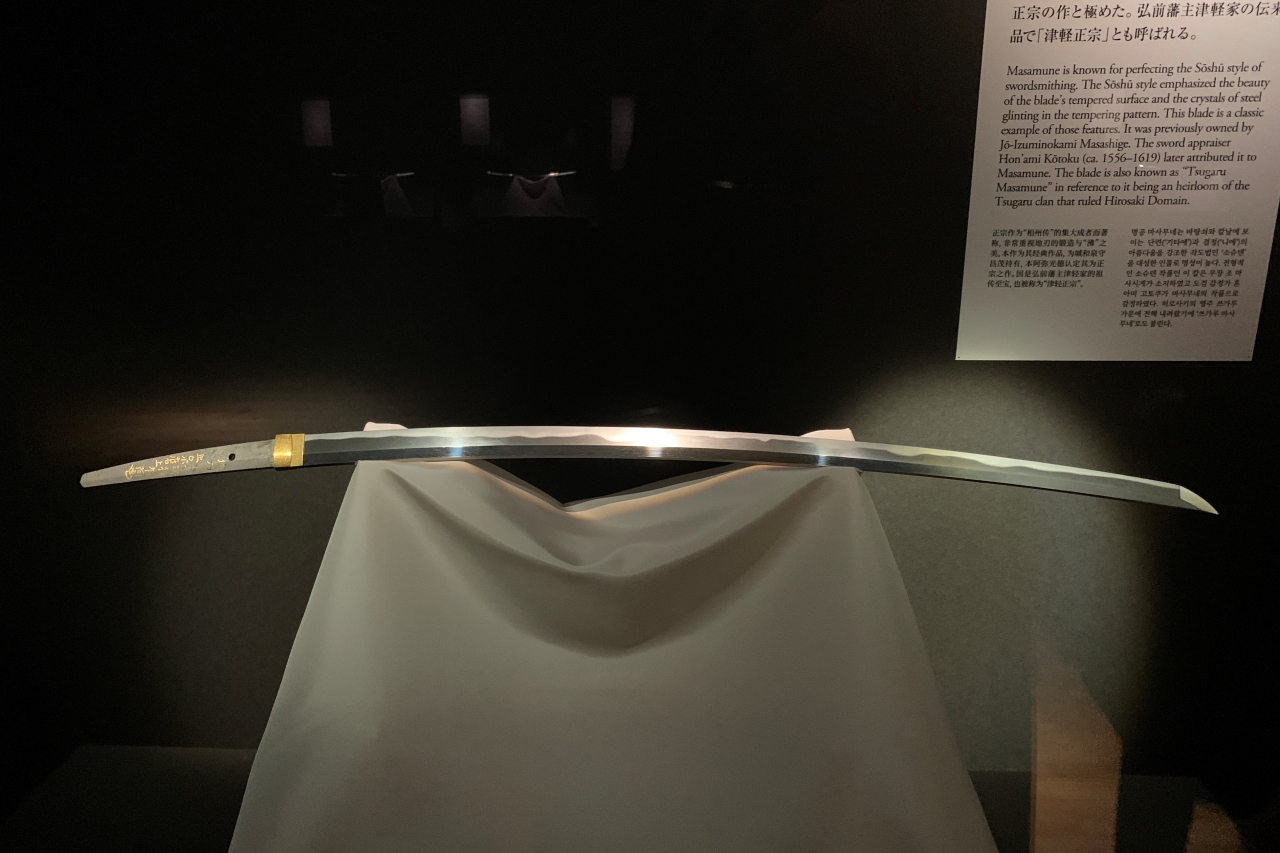
Masamune Sōshū 《Sword with gold inlay inscription Jo Izumi no kami possessed Masamune majohona (kao)》 Kamakura period, 14th century, Exhibition period: Full year
It is a story that he was very particular about the display case and lighting so that he could appreciate the blade pattern and metals more beautifully. Certainly, the entire space is dark, so the lighting in the work looks great.
A sword that suddenly emerges in a solemn atmosphere. I couldn't help but let out a sigh of admiration at the lustrous beauty of the glittering tip.
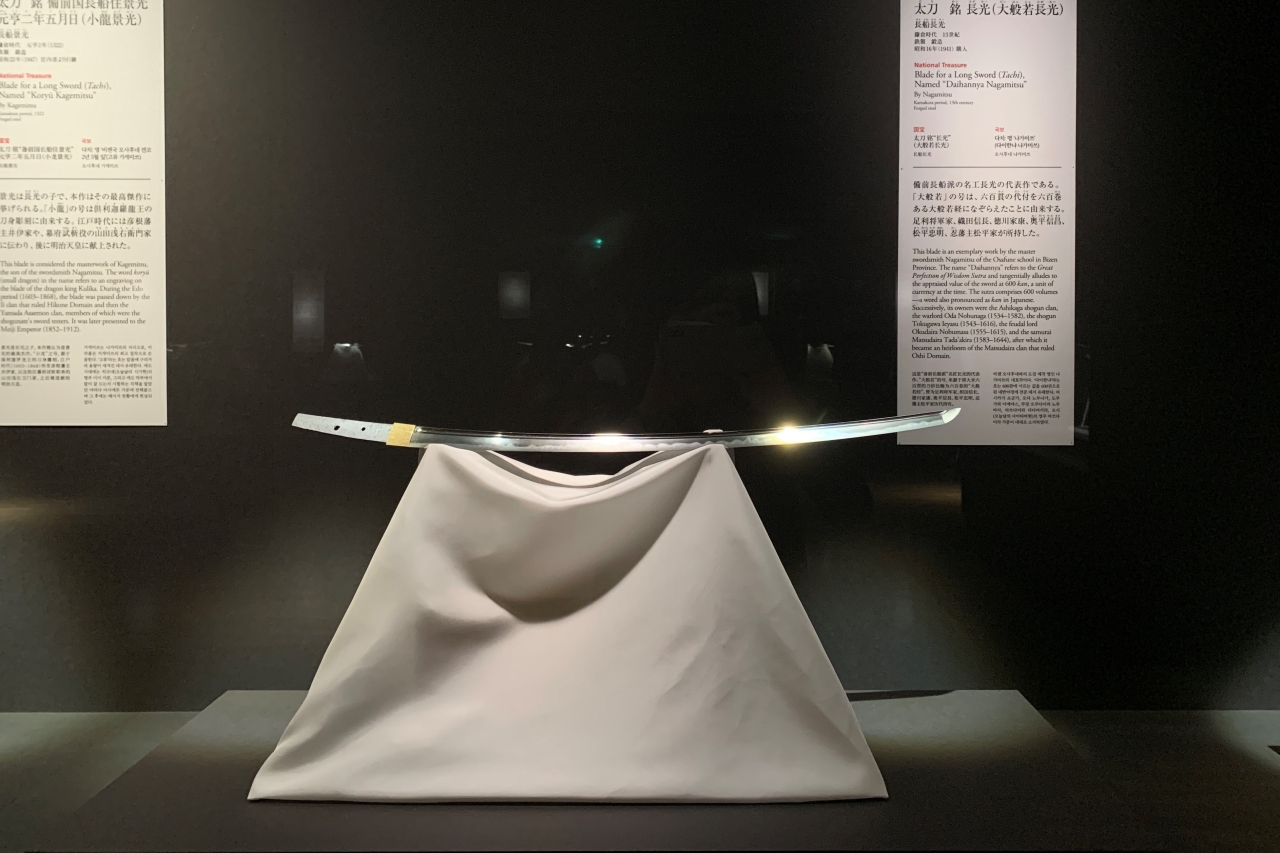
Nagamitsu Osafune, Sword Signed Nagamitsu (Daihannya Nagamitsu), Kamakura period, 13th century, Exhibition period: Full year
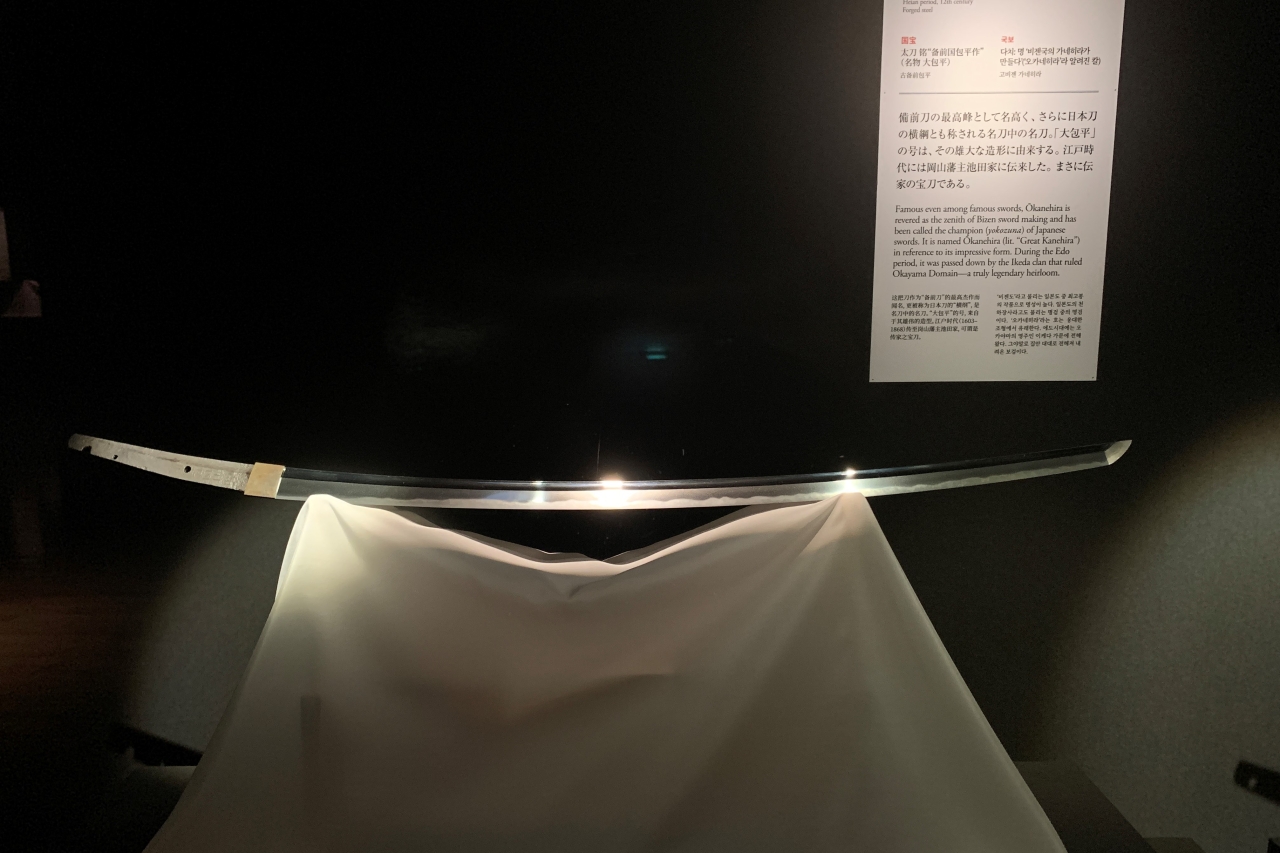
Old Bizen Kanehira 《Tachi signed by Bizen Province Kanehira (specialty Ōkanehira)》 Heian period, 12th century, Exhibition period: Full year
Mikazuki Munechika, Okanehei, Oohannya Nagamitsu, Koryu Kagemitsu, Atsutoushiro Shiro, and Kikko Sadamune , who are the motifs of the characters in the popular game "Touken Ranbu -ONLINE-", have also been discovered!
Isn't it an irresistible space for fans?
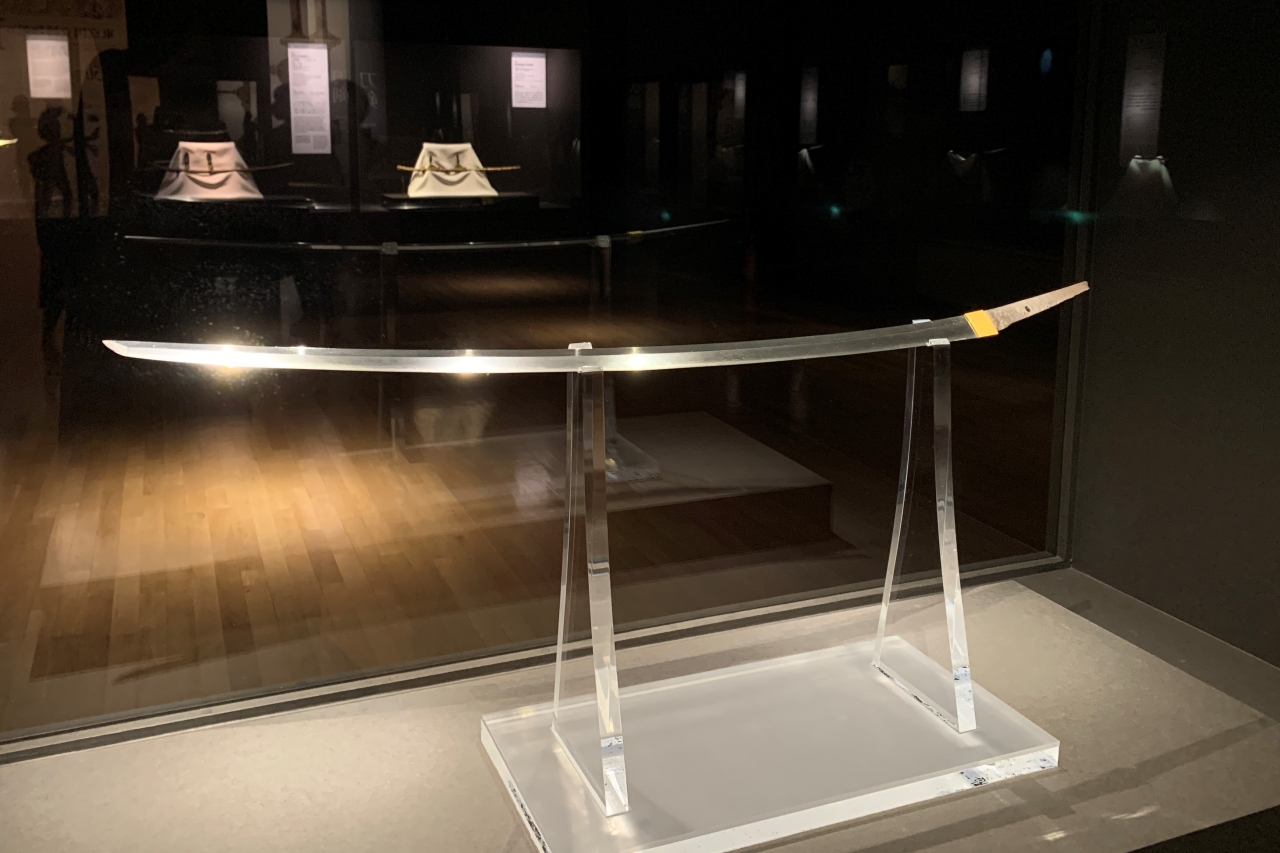
Sanjo Munechika, Sword signed Sanjo (Mikazuki Munechika), Heian period, 10th-12th century, Exhibition period: All year
What attracted attention was Mikazuki Munechika wearing an elegant sword, displayed in the center of the "National Treasure Sword Room". It is a representative work of Munechika, who was active in the late Heian period in Sanjo, Kyoto, and is known as a master craftsman of the early stage of Japanese swords. increase.
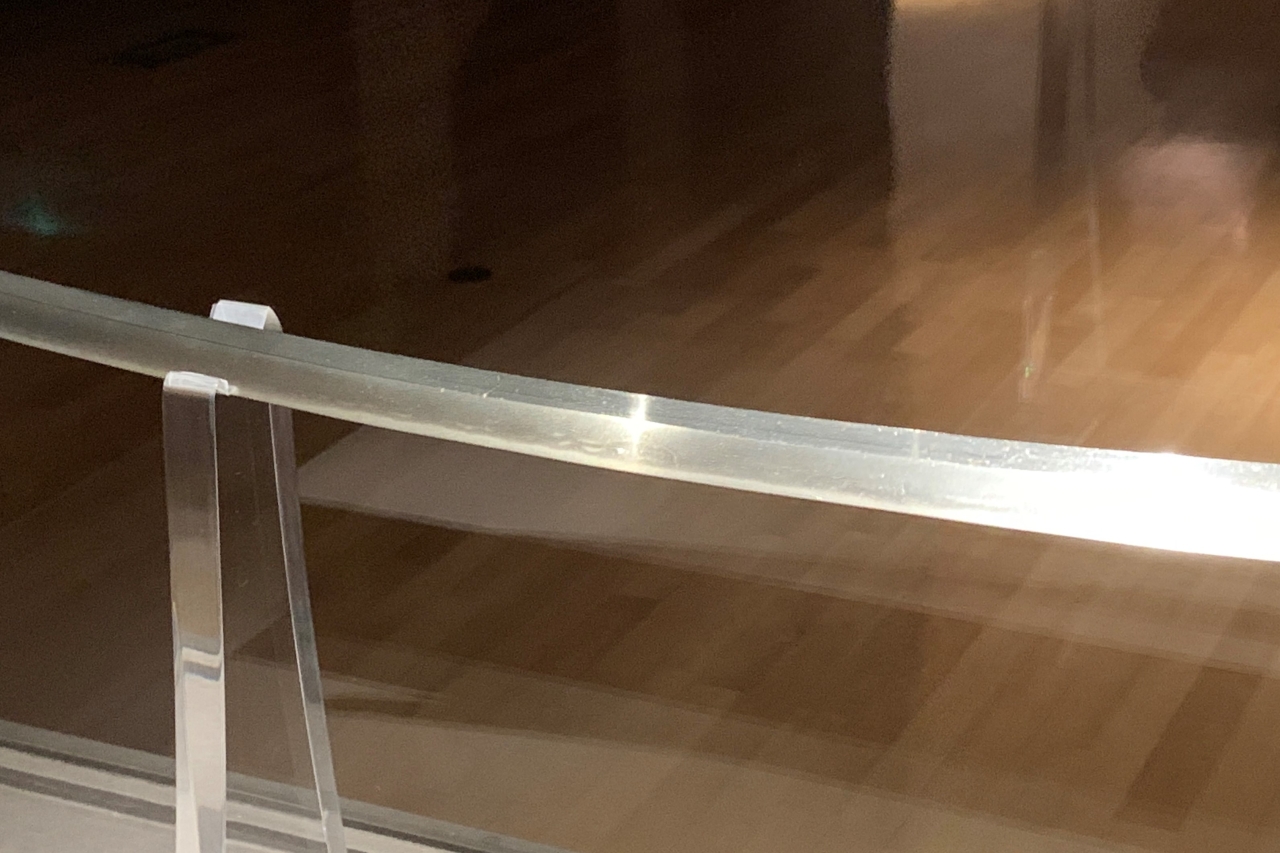
Sanjo Munechika 《Tachi signed Sanjo (specialty Mikazuki Munechika)》 (detail)
I could see a series of small scratches called uchi-no-ke on the blade pattern. It looks like a crescent moon, and because it is beautiful and rare, it is said that the name "crescent moon" was attached.
This is my first meeting with Mikazuki Munechika. Although I knew the origin of the name, I had assumed that it had a single large pattern that could be recognized as a crescent moon, so I was surprised to find that it actually had small dots.
To be honest, my first impression was, "It looks like a crescent moon… can you see it…?"

Kiyasutsuna 《Tachi signed Yasutsuna (Specialty Dojikiri Yasutsuna)》 Heian period, 10th-12th century, Exhibition period: Full year
At a press conference prior to the event, it was announced that, like Mikazuki Munechika, Dojikiri Yasutsuna, who is famous as a Japanese sword in its early stages, actually has exactly the same blade dimensions. Since I was listening to the story, I decided to actually compare it with "There is such a coincidence!"
The impression of the appearance is quite different, and Mikazuki Munechika is a slender sword that tapers toward the tip. Dojigiri Yasutsuna, on the other hand, has a solid, powerful sword with a somewhat wild feel. Also, Mikazuki Munechika has a strong angle between the stem of the handle and the blade, or rather, it is strongly aligned, but Dojigiri Yasutsuna draws a smooth curve between the stem and the blade. It looked like there was
This difference may be due to the regional culture of the author Yasutsuna, who was based in Hoki Province (present-day Tottori Prefecture), as opposed to Munechika, who was based in Kyoto. I was wondering if there would be any. The same national treasure, the same era, and the same dimensions, but the beauty of the swords is completely different. This extravagant way of enjoying is probably unique to this exhibition.
Among the exhibited works, the swords in particular have something that can only be seen when the light slides over the blade. You can enjoy the charm in the best exhibition space full of commitment, so I sincerely recommend it to those who are not fans of swords!
Regarding swords, all 19 cases are open to the public throughout the year.
Stuffed giraffes also return home for the first time in about 100 years! Looking back on 150 years of Tokyo Expo
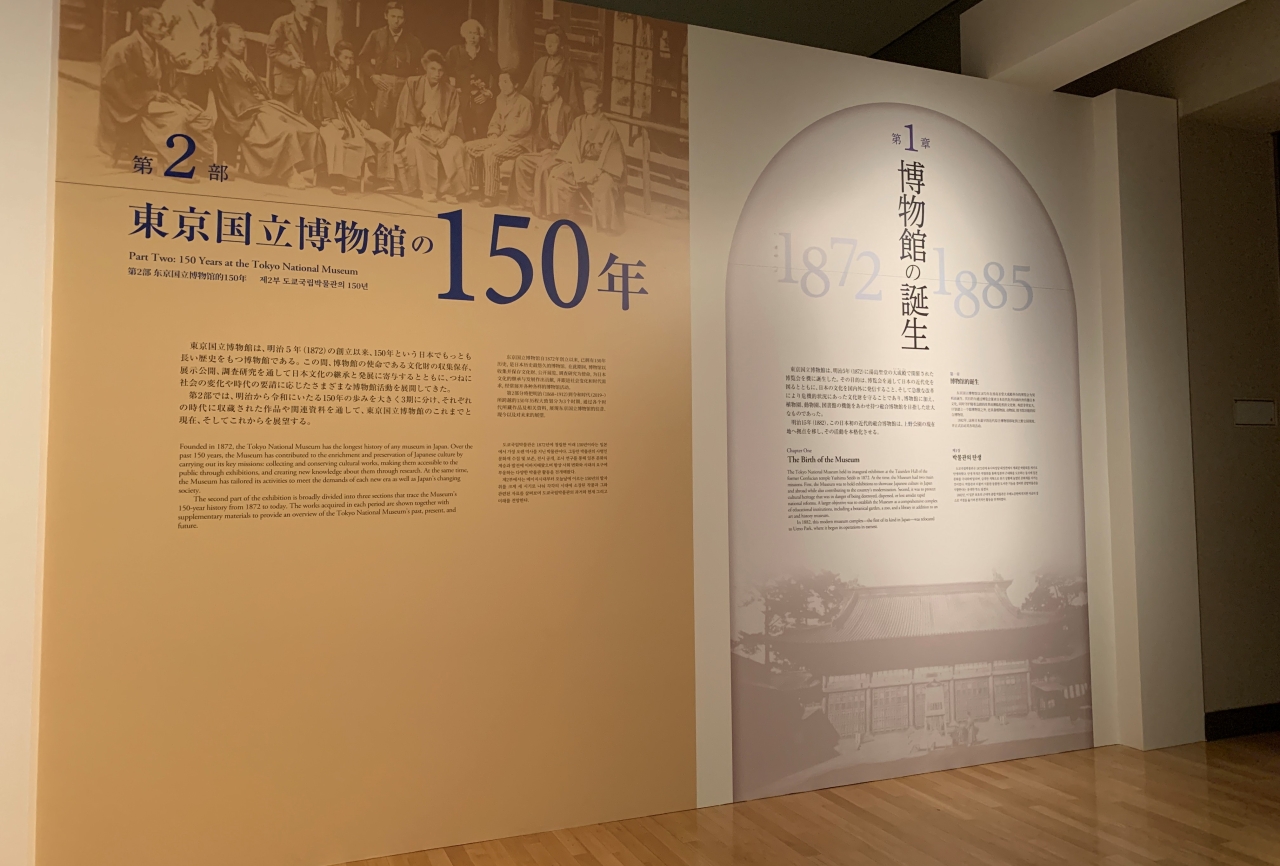
"Part 2: 150 Years of the Tokyo National Museum"
Tohaku has its roots in the Museum of the Ministry of Education, which was born in 1872 as a result of the Yushima Seido Exposition held at the Taiseiden of the former Yushima Seido. In order to promote the modernization of Japan , to disseminate Japanese culture both domestically and internationally, and to protect cultural assets, the museum was originally intended to be a comprehensive museum with the functions of a botanical garden, a zoo, and a library .
In 1882, he moved his base to Ueno and started full-scale activities. In 1886 (Meiji 19), the museum came under the jurisdiction of the Imperial Household Ministry , and in 1889 (Meiji 22), it was renamed the "Imperial Museum", and in 1900 (Meiji 33), it was renamed "Tokyo Imperial Household Museum". At this time, it was positioned as a cultural symbol of the nation, as well as a temple of beauty that protected the treasures of the imperial family, and gradually strengthened its character as a museum of history and art.
The current main building opened in 1938, and after the end of the war, the jurisdiction changed from the Imperial Household Ministry to the Ministry of Education again. In 1952, the name was changed to the current "Tokyo National Museum" , and it continues to this day with new facilities such as the Oriental Museum, Museum, and Horyuji Treasure Museum.
In the following "Part 2: 150 Years of the Tokyo National Museum" , collections and related materials that tell the story of the Tokyo National Museum's 150-year history are exhibited in three periods. You can relive the steps from the Meiji era.
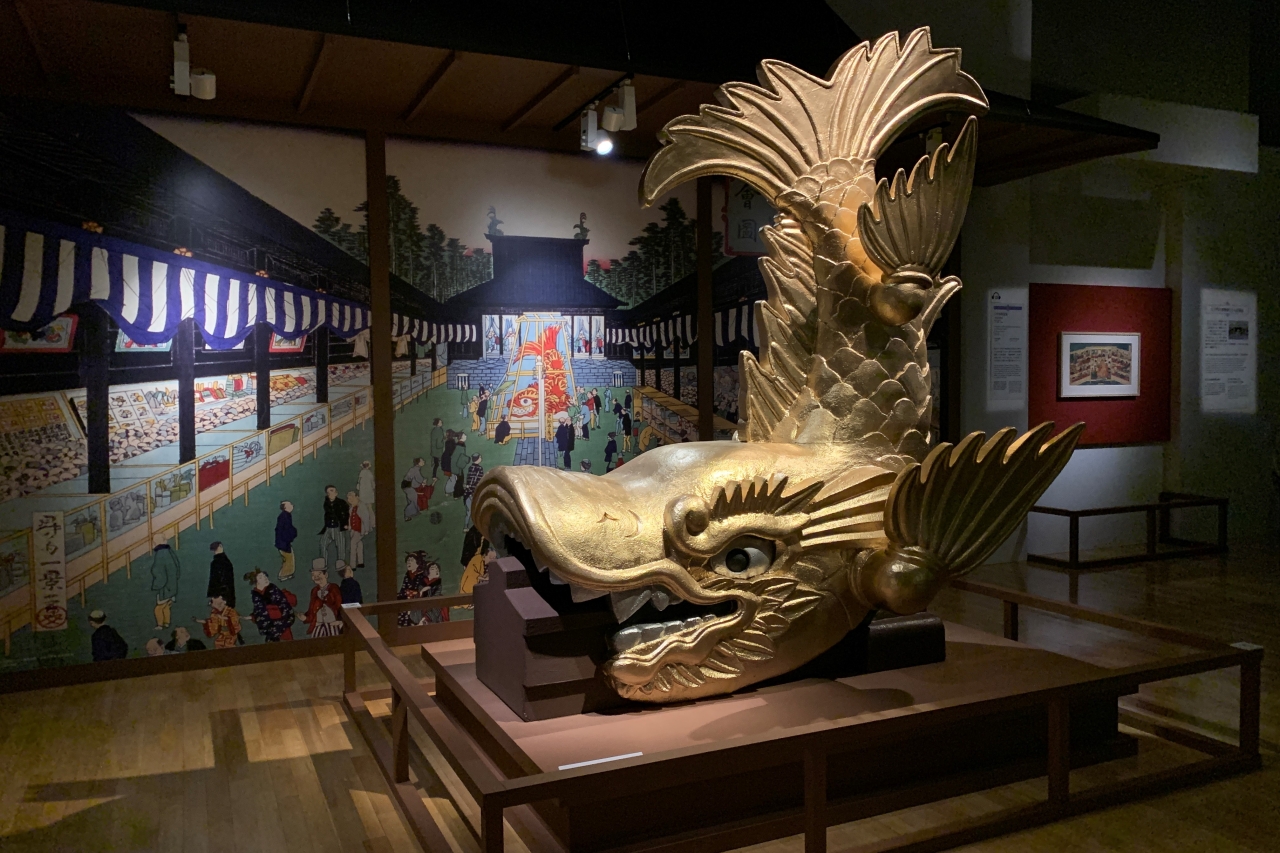
Life-size replica of Nagoya Castle Golden Shachi
"Chapter 1: The Birth of the Museum (1872-1885)" introduces works exhibited at the Yushima Seido Exposition, which triggered the birth of the Tohaku, with a focus on the early Tohaku collection. In order to recreate the atmosphere of the exposition, there is a life-size replica of the golden dolphin of Nagoya Castle, which was said to have been the most popular at the time.
It is said that some of the display cases were actually used over 100 years ago and have been repaired and put to good use, so be sure to check them out. The retro atmosphere is irresistible.
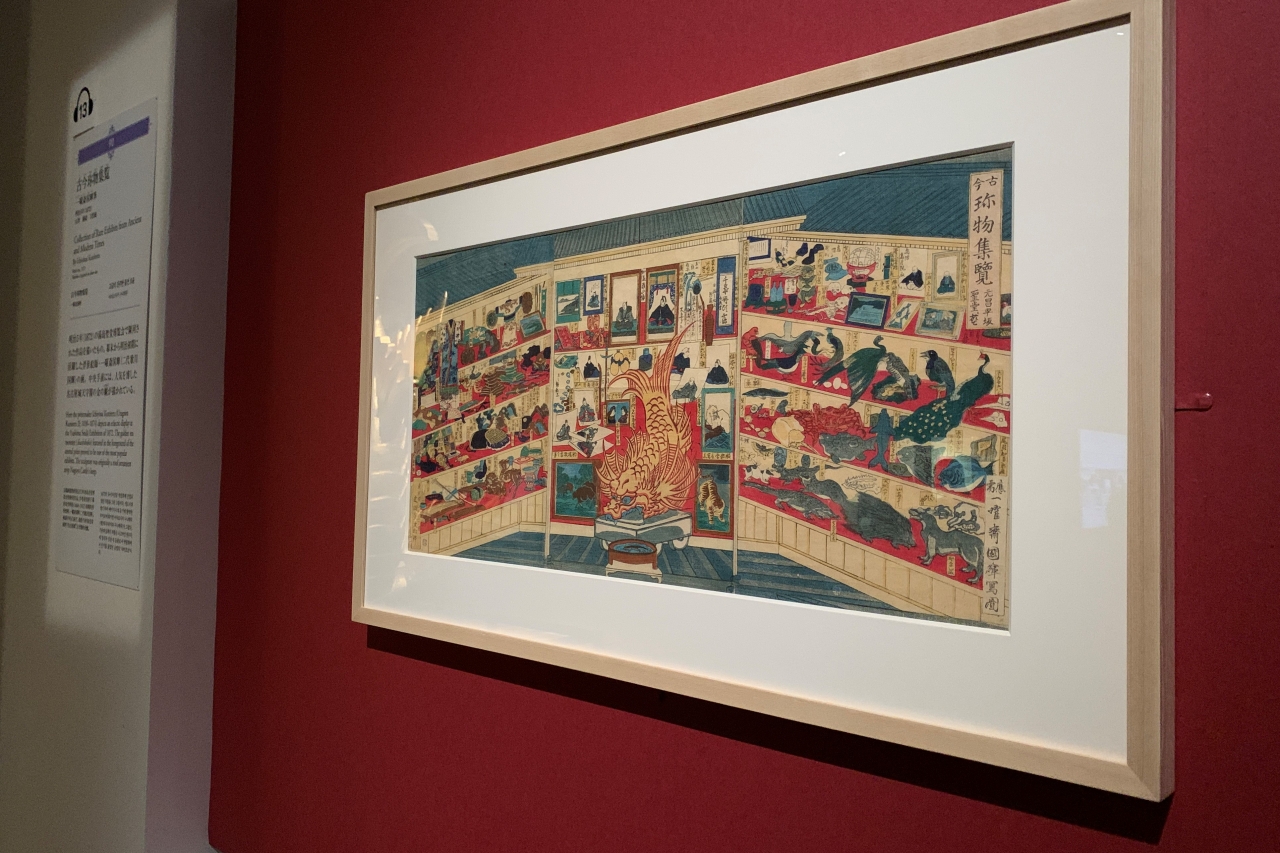
"Ancient and Modern Ceramics Collection" depicting the items that were popular at the Yushima Seido Exposition / Ichiyosai Kokuteru "An Ancient and Modern Ceramics Collection" 1872 (Meiji 5)
Even the author, who lives in the Reiwa era, was astonished by the brown-glazed crab-covered pedestal bowl and the eagle figurine , which made the world know about the high level of Japanese craftsmanship in the Meiji period.

Important Cultural Property, Kozan Miyagawa I, Brown Glaze Crab Attached Bowl with Base, 1881, Exhibition period: All year
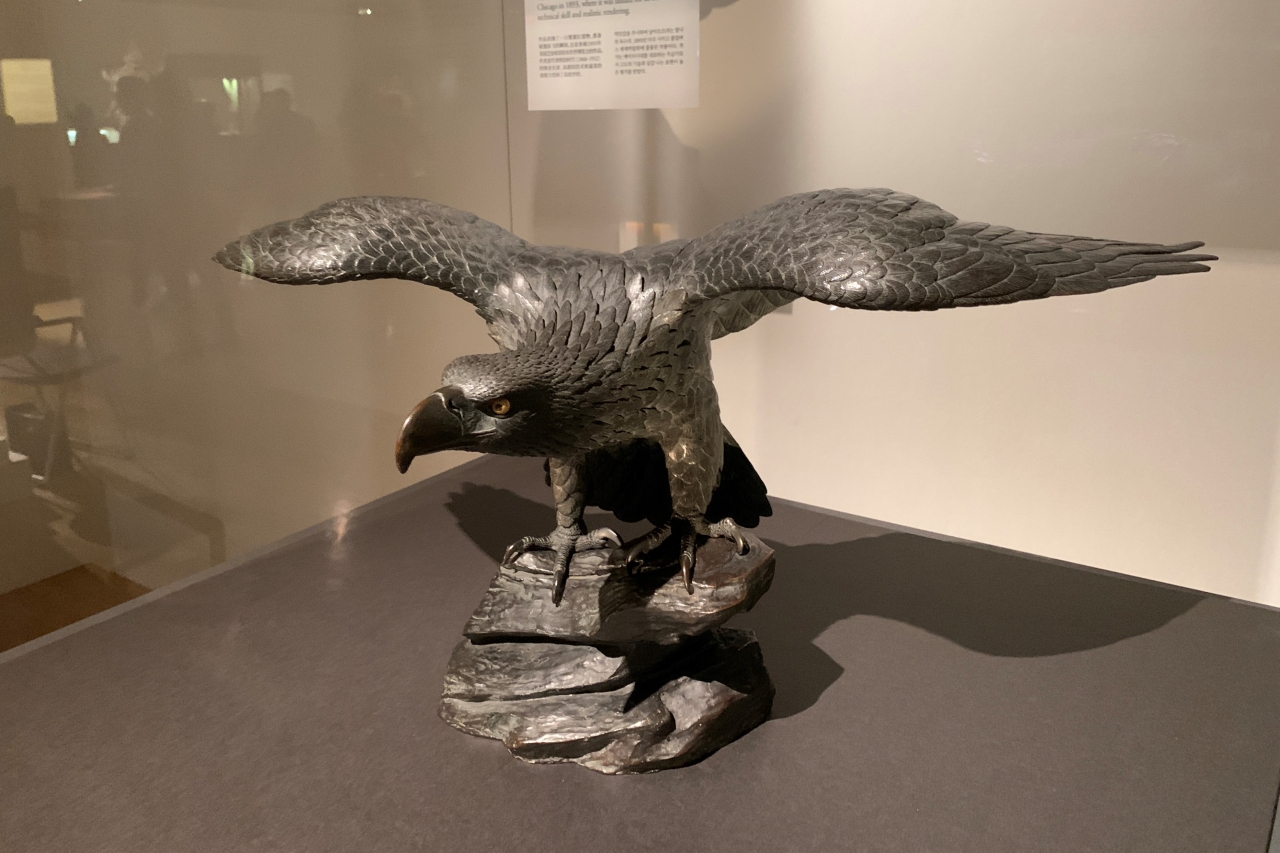
Important Cultural Property, Suzuki Chokichi's "Eagle Figurine" 1892, Exhibition period: All year
A pot with brown glaze crab affixed to a table by Kazan Miyagawa I, a pioneer of exporting ceramics, was held in Ueno Park in 1881, and the second exhibition attracted more than 800,000 people in about four months. Works exhibited at the National Industrial Exhibition. It is a work with a dynamic composition in which a crab, which looks as if it is about to start moving at any moment, is hooking its claws on the edge of a vessel.
On the other hand, "Eagle Figurine" is a representative work of Chokichi Suzuki, a master of wax mold casting representing the Meiji era. After being exhibited at the Chicago World's Fair held in the United States in 1893 (Meiji 26), it was acquired by the Tohaku. From a distance, it looks so lively that it can be mistaken for a stuffed animal.
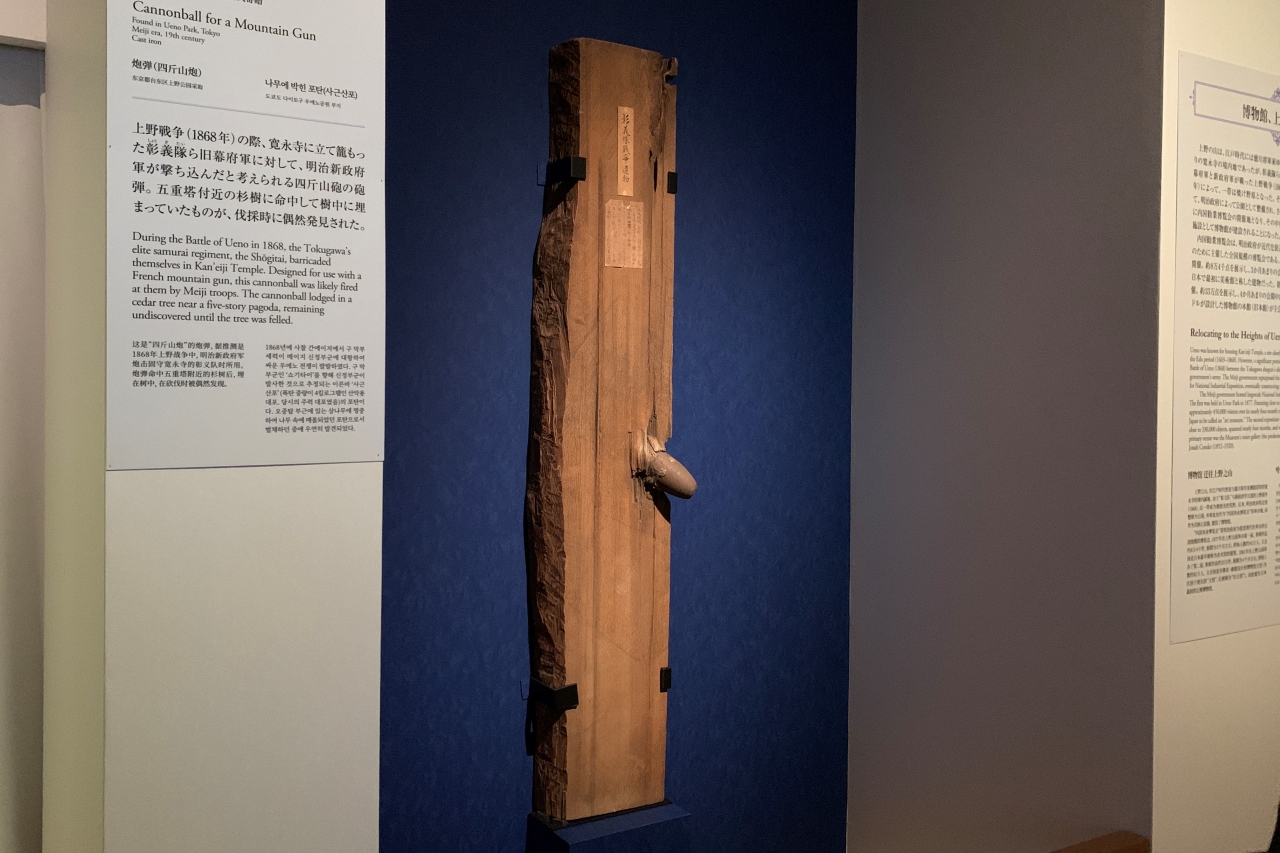
《Cannonball (Yonkoyama Gun)》 Collected from Ueno Park, Taito-ku, Tokyo, Meiji period, 19th century Exhibition period: All year
There is also an exhibition of Cannonballs (Four Lobster Cannons) , which is related to the birth of Tokyo Expo.
During the Ueno War that occurred in 1868 (Meiji 1), this is the actual cannonball that the new Meiji government forces fired at the former shogunate forces, including the Shogitai, who barricaded themselves in Kan'eiji Temple. Currently, Kaneiji Temple is adjacent to the north side of Tohaku, but in fact, the land of Ueno Park was the precincts of Kaneiji Temple during the Edo period.
Kan'ei-ji Temple, which was considered to have sheltered the Shogitai, once had all of its precincts confiscated. After that, there were twists and turns, most of the land was transformed into Ueno Park, and museums and expositions were held to promote modernization. I think that today's Ueno Park, and by extension the Tokyo Expo, exist because it was a burnt-out land in the Ueno War and was just the right place to build a town. Although it is a sad event, it may be said that the Ueno War was one of the reasons for the birth of Tohaku.
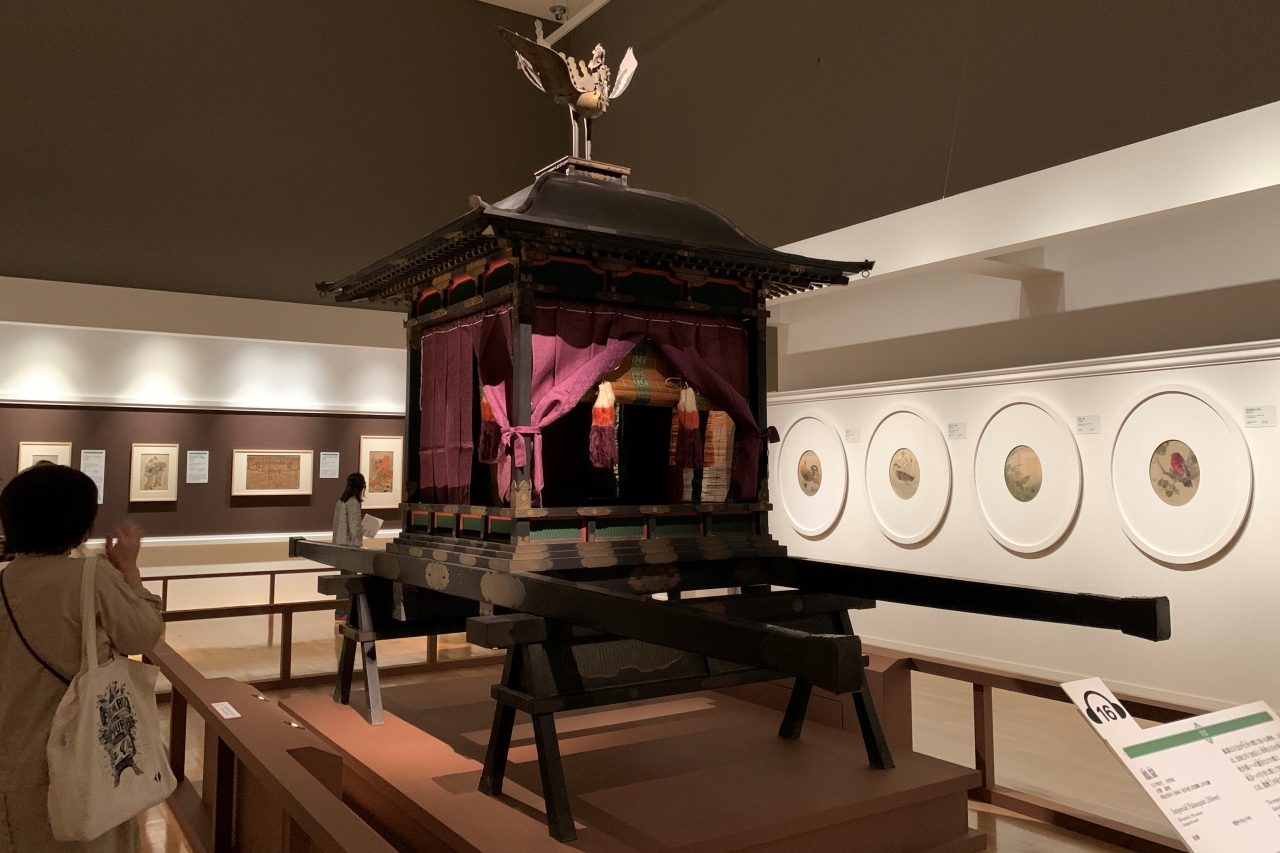
《Phoenix》Edo period, 19th century
"Chapter 2: The Imperial Family and Museums (1886-1946)" features the Tokyo Expo when it was under the jurisdiction of the Ministry of the Imperial Household. We also introduce works that show the connection with the imperial family.
In relation to the imperial family, the giant carriage called "Horen" had a particularly noble aura. It is said that Emperor Komei and Emperor Meiji actually rode the phoenix, which was used by the emperor when he visited.
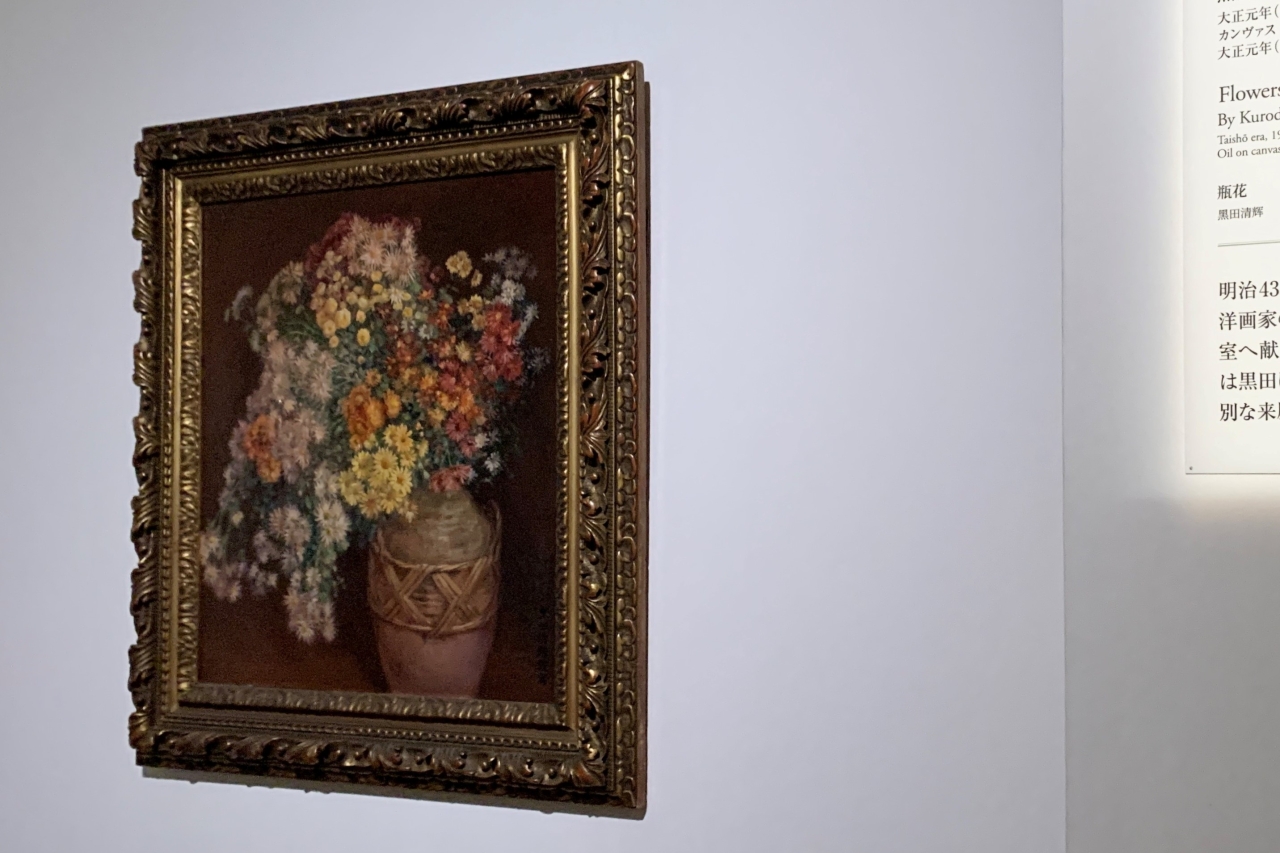
By Seiki Kuroda, Flower in a Bottle, 1912
In 1890 (Meiji 23), there was a system called the Imperial Household Technician System, which was established by the Imperial Family as a system to protect and encourage outstanding artists. It is said that
"Flowers in a Bottle" is a work by Kuroda Seiki, the first Western-style painter to be appointed as an Imperial Household Technician. At the bottom right of the screen is the signature "Kuroda Seiki's copy", which is rare for Kuroda's work. It suggests a special history of being an offering to the imperial family.

<< stuffed giraffe specimen >> Meiji 14 (1908), National Museum of Nature and Science
Also, there is a stuffed giraffe specimen that gives you a sense of the remnants of the Tokyo Expo when it was aiming to be a general museum!
Natural history materials such as specimens of animals, plants and minerals were transferred to the Tokyo Museum (currently the National Museum of Nature and Science) after the Great Kanto Earthquake. It has become a form of going home.
He was one of the first two giraffes to come to Japan alive from Germany in 1907, and his name was "Fanji." He was raised at the Ueno Zoo, which was part of the Tokyo Expo at the time, and became popular with many people.
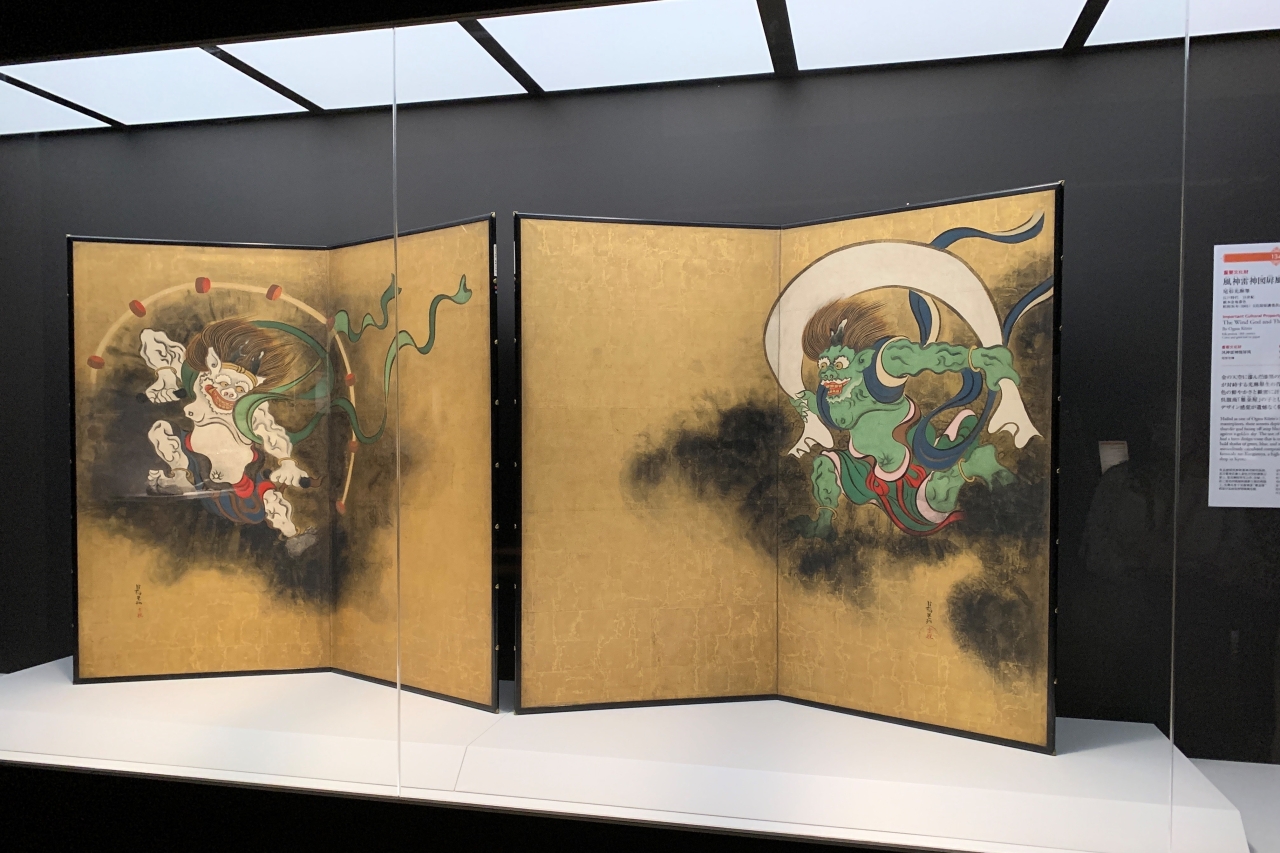
Important Cultural Property, By Korin Ogata, Wind God and Thunder God Folding Screen, Edo period, 18th century, Exhibition period: 10/18-11/13
"Chapter 3: Towards a New Museum (1947-2022)" describes the activities that Tohaku has undertaken since the end of World War II, as a museum open to the public, in response to the changing times and changes in society. The future prospects are introduced along with representative post-war collections.
Many famous works are on display here as well as in the national treasure area, such as Korin Ogata's "Fujin Raijin-zu Folding Screen" , which is an important cultural property, and "Shakoki Dogu", which many people may think of as clay figurines. It was done.

Important Cultural Property, 《Shade figurine》Jomon period, 1000-400 BC, Exhibition period: All year
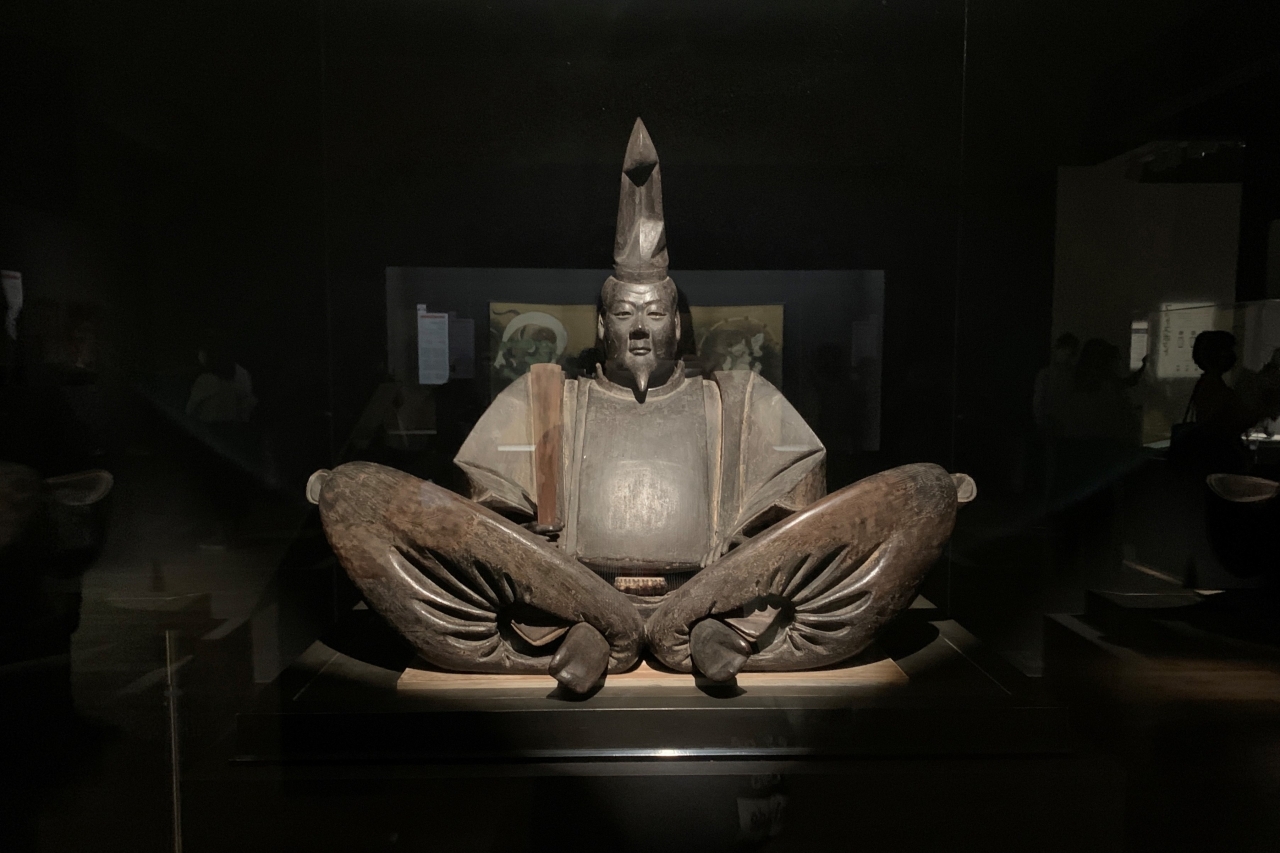
Important Cultural Property, Seated Statue of Minamoto no Yoritomo, Kamakura period, 13th-14th century, Exhibition period: All year
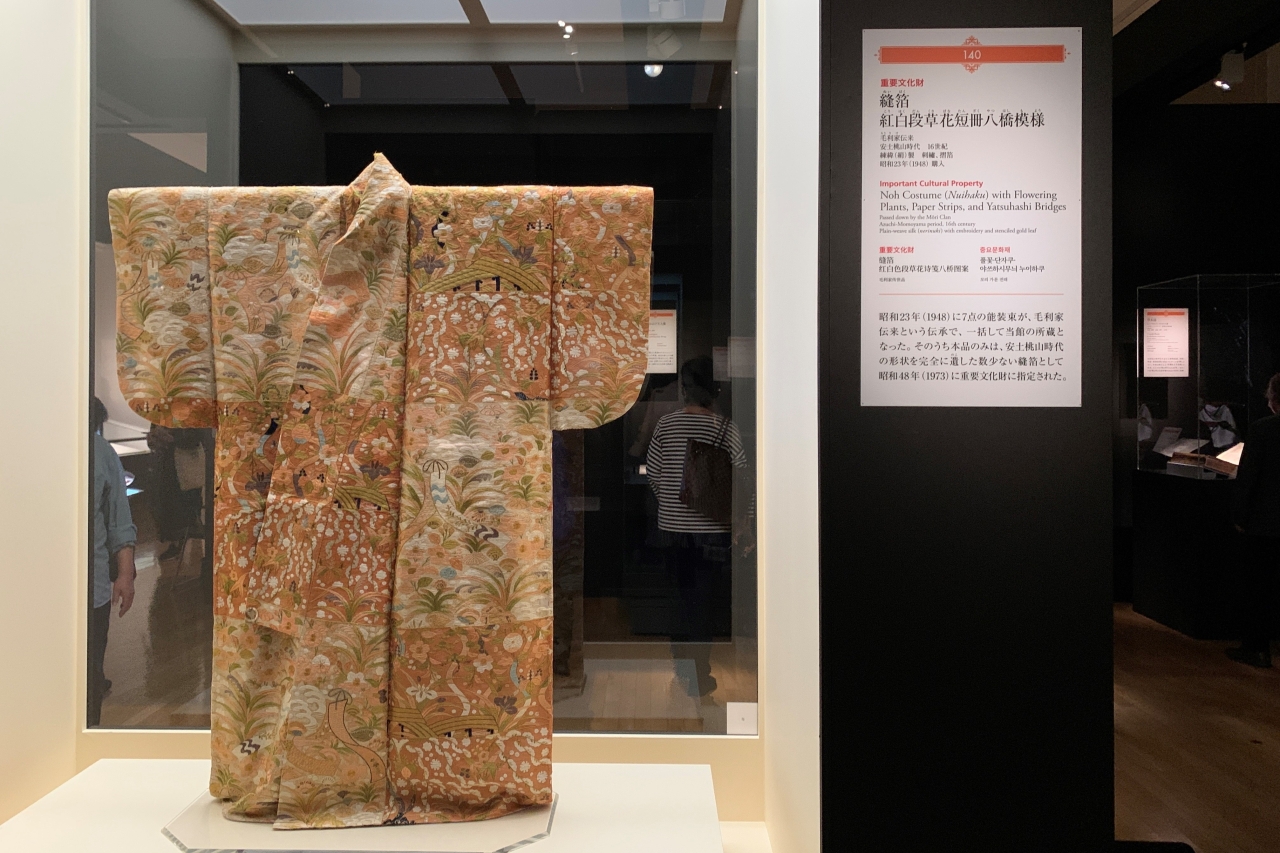
Important Cultural Property, "Nuihaku Red and white tiered flower tanzaku Yatsuhashi pattern" Azuchi-Momoyama period, 16th century, exhibition period: all year
As the latest collection of Reiwa, the appearance of the "Kongo Rikishi Statue" that became the collection of the Tokyo National Museum in February this year.
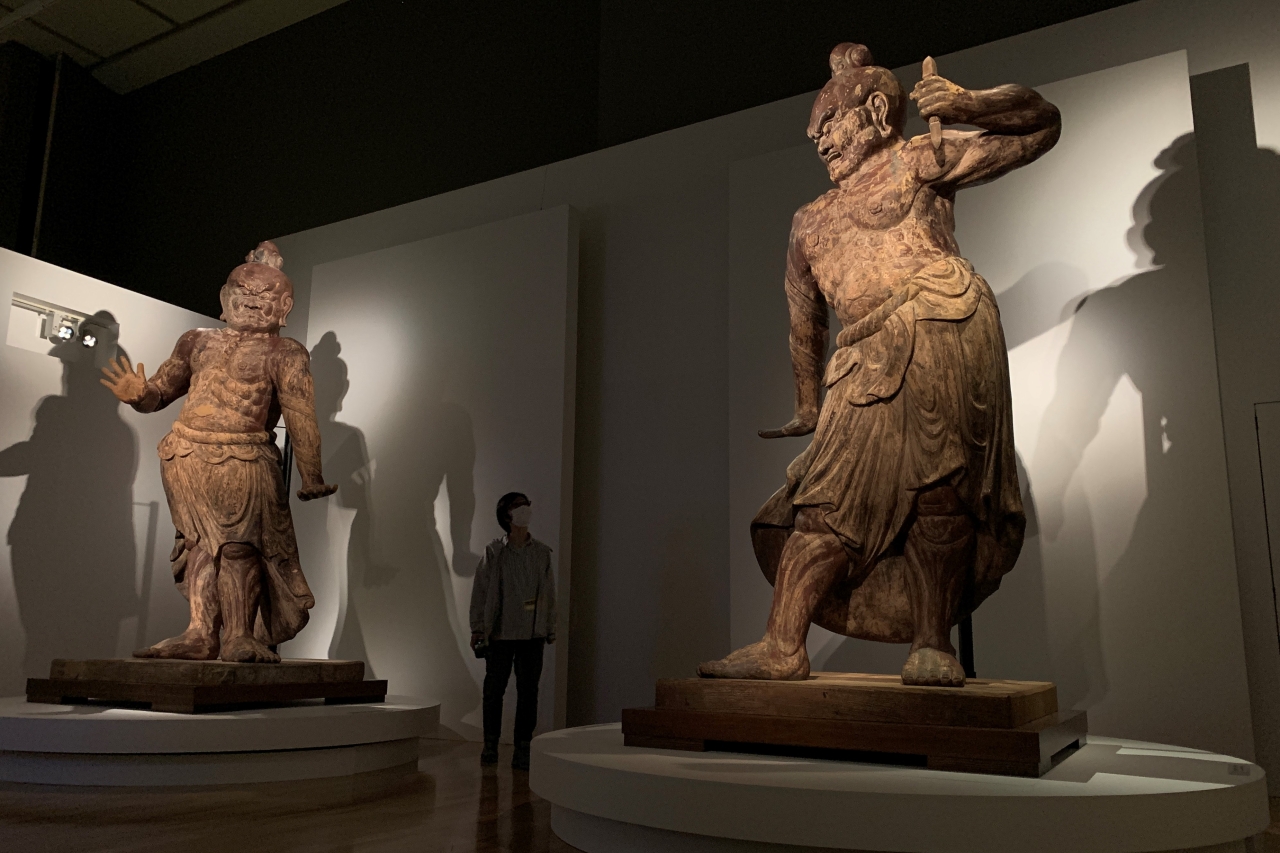
《Standing Kongo Rikishi》Heian period, 12th century, exhibition period: all year
These two statues were once enshrined at the Niomon Gate of Rendaiji Temple in Shiga Prefecture, but they were destroyed by the Muroto Typhoon in 1934. Although it remained broken for a long time, it was repaired over the course of two years and restored to its former appearance, making its debut at this exhibition.
It is one of the few standing statues of Kongo Rikishi from the late Heian period. It is about 2m80cm in size, and is the largest among the Buddha statues owned by the Tohaku. You can enjoy the 360-degree view of their muscular bodies and angry expressions.
In addition, this work also introduces the basic activities of the Tokyo Expo, such as the collection, storage, preservation, and restoration of cultural properties.
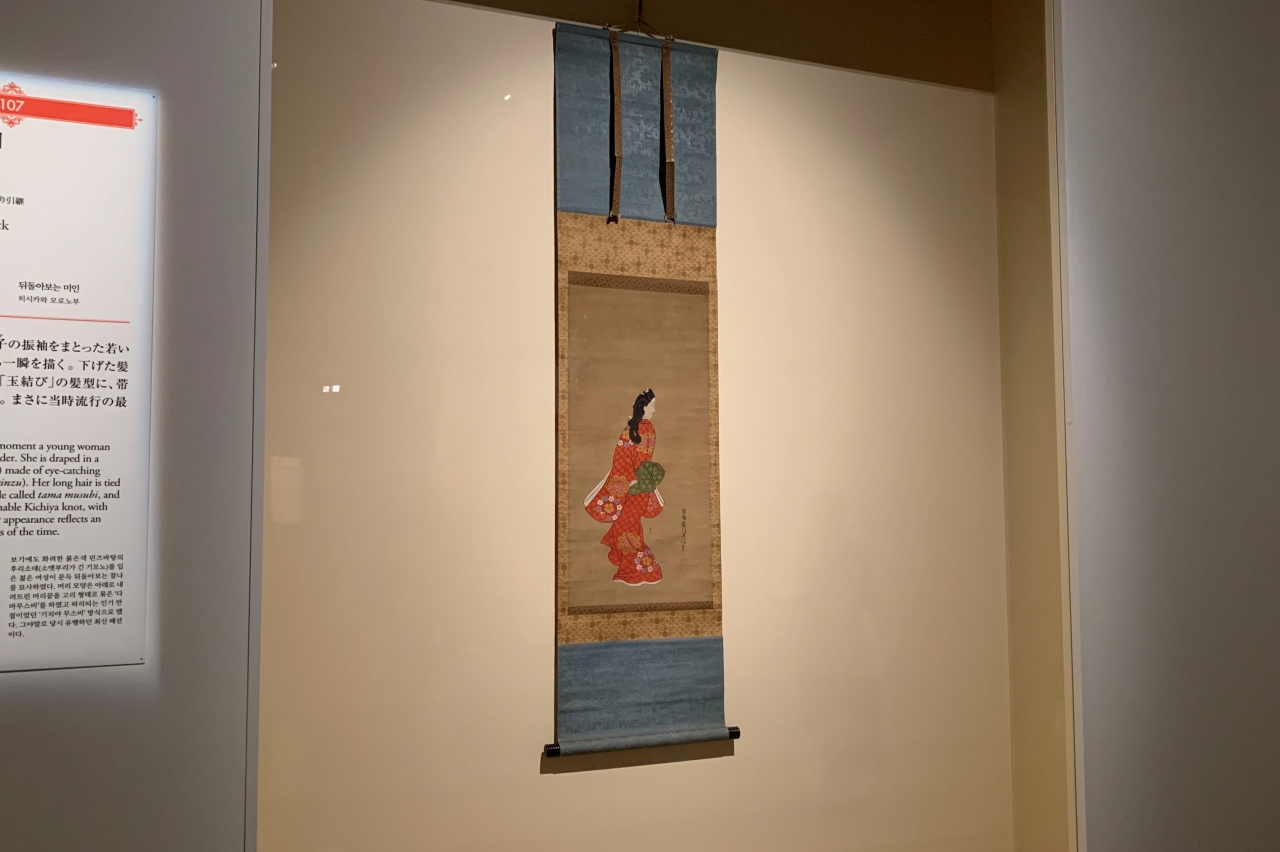
Hishikawa Moronobu 《Beauty Looking Back》Edo period, 17th century, Exhibition period: 10/18-11/13 (reproduced painting on display from 11/15-12/11)
At the exit, Moronobu Hishikawa's "Mikaeri Bijin Zu" sees visitors off. Or does it represent the feelings of the visitors who involuntarily look back at the venue with regret?
By the way, photography was allowed only for the Kongo Rikishi Statue and the Mikaeri Bijinzu, which will be described later.
During its 150 years of history, the Tokyo Expo has hosted several exhibitions that have been handed down from generation to generation, such as "Tutankhamun Exhibition" (1965) and "Mona Lisa Exhibition" (1974). All of the National Treasures of the Tokyo National Museum will surely be one of them. Don't miss this precious opportunity!
Tokyo National Museum 150th Anniversary Special Exhibition “All About the National Treasures of the Tokyo National Museum” Overview
*Advance reservations are required for this exhibition (specified date and time). For details, please check the official website of the exhibition.
*Some of the works on display will be changed during the exhibition period.
| exhibition period | October 18th (Tue) – December 11th (Sun), 2022 |
| venue | Tokyo National Museum Heiseikan |
| Opening hours | 9:30 a.m. to 5:00 p.m. *Open until 8:00 p.m. on Fridays and Saturdays (General cultural exhibition closes at 5:00 p.m.) |
| closing day | Monday |
| Viewing fee (tax included) | General 2,000 yen, university students 1,200 yen, high school students 900 yen
*Advance reservations are required for this exhibition (specified date and time). |
| organizer | Tokyo National Museum, Mainichi Shimbun, NHK, NHK Promotions, Japan Arts Council, Agency for Cultural Affairs |
| inquiry | 050-5541-8600 (Hello Dial) |
| Exhibition official website | https://tohaku150th.jp/ |
*The content of the article is as of the date of the interview (October 17, 2022). Please check the official website for the latest information.
<Past Exhibition Reports>
The essence of 20th century art is now here. [National Museum of Western Art] "Picasso and His Era Berlin State Berggruen Museum Exhibition" Preview Report (-2023/1/22)
Click here for the list of reports


